Paul van Yperen's Blog, page 275
April 11, 2018
Garbo by Clarence Sinclair Bull
Portrait photographer Clarence Sinclair Bull (1896-1979) was 'The man who shot Garbo'. In 1919 producer Samuel Goldwyn hired him to make publicity stills of the stars of Goldwyn's studio. When Metro-Goldwyn-Mayer was founded in 1924, Bull was appointed as the head of their stills department and stayed there until retiring in 1961. He was responsible for managing MGM's staff of photographers and the large support crew of technicians needed to develop, re-touch print and collate the hundreds of thousands of prints distributed annually by MGM's publicity department. He is most famous for his photographs of Greta Garbo taken during the years of 1926-1941. Bull's first portrait of Garbo was a costume study for The Flesh and the Devil, in September 1926. Bull was the ideal collaborator for the sensitive Garbo. From her last silent film The Kiss (1929) until Two-Faced Woman in 1941, Bull was to take all Garbo's portraits with the exception of the film Romance (1930) for which George Hurrell took the portraits.
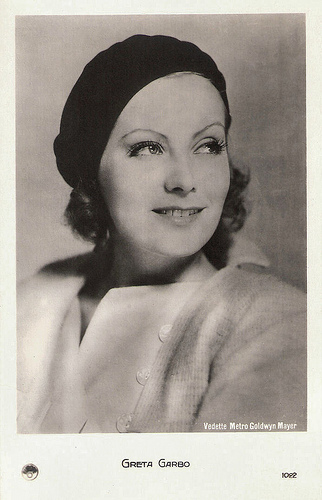
French postcard by Europe, no. 1022. Photo: Clarence Sinclair Bull / Metro-Goldwyn-Mayer. Publicity still for The Kiss (Jacques Feyder, 1929).
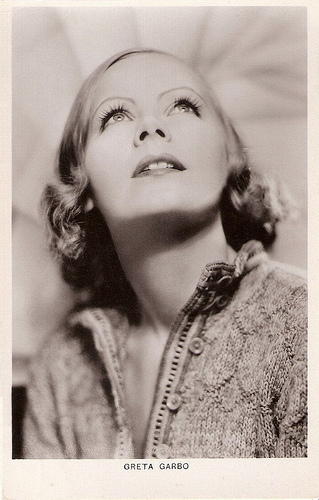
British postcard in the 'Picturegoer' Series, London, no. 2836. Photo: Clarence Sinclair Bull. Publicity still for The Kiss (Jacques Feyder, 1929).
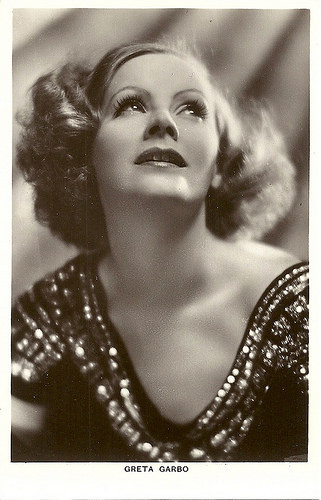
British postcard in the Picturegoer series, no. 283p. Garbo wears the dress from her lesser known film Inspiration (Clarence Brown, 1931). Photo: Clarence Sinclair Bull, 1930.
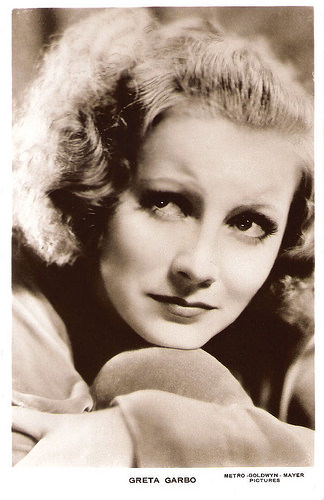
British postcard. Photo: Clarence Sinclair Bull / Metro Goldwyn Mayer. Publicity still for Inspiration (Clarence Brown, 1931).
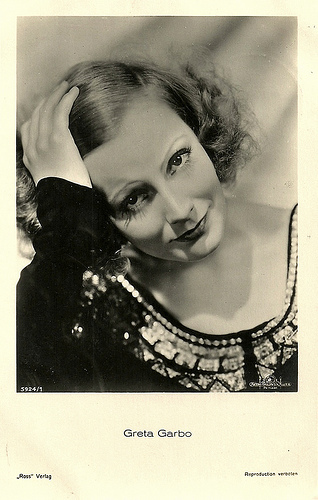
German postcard by Ross Verlag, no. 5924/1, 1930-1931. Photo: Clarence Sinclair Bull / Metro Goldwyn Mayer. Publicity still for Inspiration (Clarence Brown, 1931).
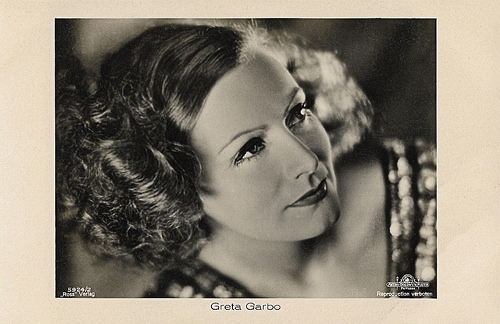
German postcard by Ross Verlag, no. 5924/2, 1930-1931. Photo: Clarence Sinclair Bull / Metro Goldwyn Mayer. Publicity still for Inspiration (Clarence Brown, 1931).
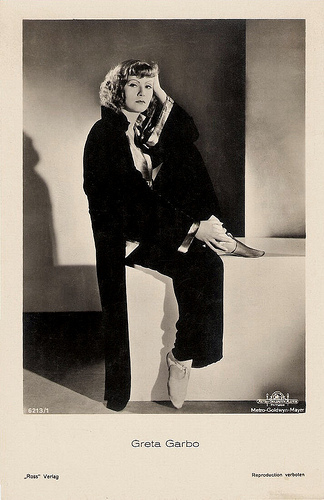
German postcard by Ross Verlag, no. 6213/1, 1931-1932. Photo: Photo: Clarence Bull / Metro-Goldwyn-Mayer. Publicity still for Susan Lenox, Her Fall and Rise (Robert Z. Leonard, 1931).
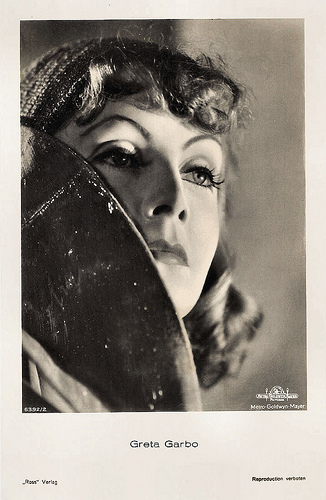
German postcard by Ross Verlag, no. 6392/2, 1931-1932. Photo: Clarence Bull / Metro-Goldwyn-Mayer. Publicity still for Susan Lenox, Her Fall and Rise (Robert Z. Leonard, 1931).
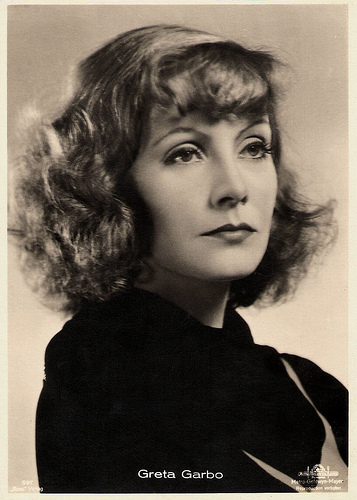
German postcard by Ross-Verlag, no. 597. Photo: Clarence Bull / Metro-Goldwyn-Mayer. Publicity still for Susan Lenox, Her Fall and Rise (Robert Z. Leonard, 1931).
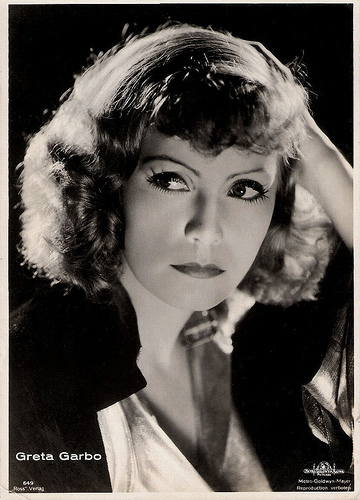
German postcard by Ross Verlag, no. 649. Photo: Clarence Bull / Metro-Goldwyn-Mayer. Publicity still for Susan Lenox, Her Fall and Rise (Robert Z. Leonard, 1931). Sent by mail in the Netherlands in 1934.
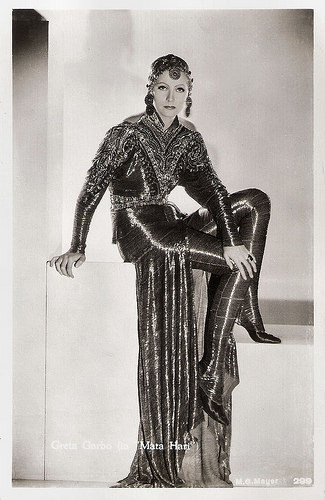
Dutch postcard by JosPe, no. 299. Photo: Clarence Sinclair Bull / Metro-Goldwyn-Mayer. Publicity still for Mata Hari (George Fitzmaurice, 1931).
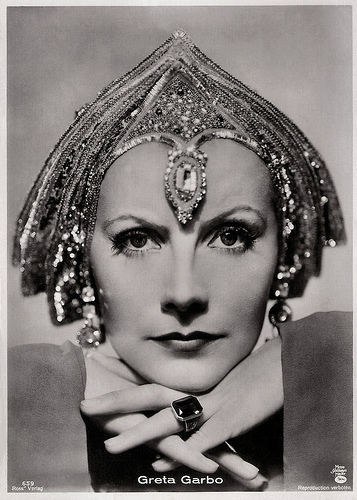
German postcard by Ross Verlag, no. 659. Photo: Clarence Sinclair Bull / Metro-Goldwyn-Mayer. Publicity still for Mata Hari (George Fitzmaurice, 1931).
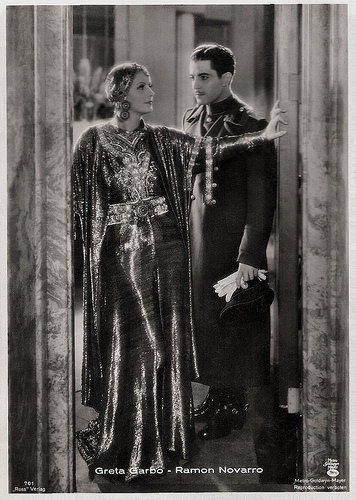
German postcard by Ross Verlag, no. 701. Photo: Clarence Sinclair Bull / Metro-Goldwyn-Mayer. Publicity still for Mata Hari (George Fitzmaurice, 1931) with Ramon Novarro .
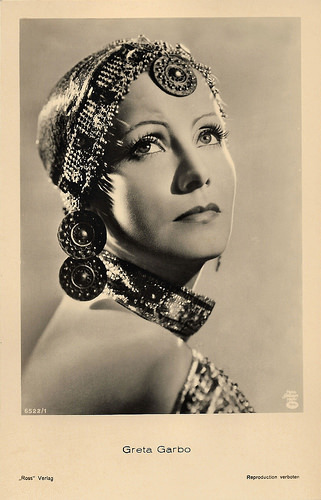
German postcard by Ross Verlag, no. 6522/1, 1931-1932. Photo: Clarence Sinclair Bull / Metro-Goldwyn-Mayer. Publicity still for Mata Hari (George Fitzmaurice, 1931).
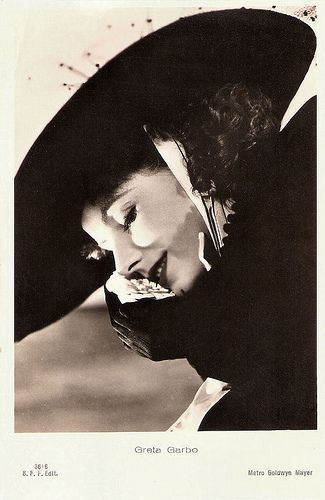
Italian postcard by B.F.F. Edit., no. 3616. Photo: Metro-Goldwyn-Mayer / Clarence Sinclair Bull. Publicity still for Camille (George Cukor, 1936).
Sources: Garbo Forever, The Eye of Photography and Wikipedia.

French postcard by Europe, no. 1022. Photo: Clarence Sinclair Bull / Metro-Goldwyn-Mayer. Publicity still for The Kiss (Jacques Feyder, 1929).

British postcard in the 'Picturegoer' Series, London, no. 2836. Photo: Clarence Sinclair Bull. Publicity still for The Kiss (Jacques Feyder, 1929).

British postcard in the Picturegoer series, no. 283p. Garbo wears the dress from her lesser known film Inspiration (Clarence Brown, 1931). Photo: Clarence Sinclair Bull, 1930.

British postcard. Photo: Clarence Sinclair Bull / Metro Goldwyn Mayer. Publicity still for Inspiration (Clarence Brown, 1931).

German postcard by Ross Verlag, no. 5924/1, 1930-1931. Photo: Clarence Sinclair Bull / Metro Goldwyn Mayer. Publicity still for Inspiration (Clarence Brown, 1931).

German postcard by Ross Verlag, no. 5924/2, 1930-1931. Photo: Clarence Sinclair Bull / Metro Goldwyn Mayer. Publicity still for Inspiration (Clarence Brown, 1931).

German postcard by Ross Verlag, no. 6213/1, 1931-1932. Photo: Photo: Clarence Bull / Metro-Goldwyn-Mayer. Publicity still for Susan Lenox, Her Fall and Rise (Robert Z. Leonard, 1931).

German postcard by Ross Verlag, no. 6392/2, 1931-1932. Photo: Clarence Bull / Metro-Goldwyn-Mayer. Publicity still for Susan Lenox, Her Fall and Rise (Robert Z. Leonard, 1931).

German postcard by Ross-Verlag, no. 597. Photo: Clarence Bull / Metro-Goldwyn-Mayer. Publicity still for Susan Lenox, Her Fall and Rise (Robert Z. Leonard, 1931).

German postcard by Ross Verlag, no. 649. Photo: Clarence Bull / Metro-Goldwyn-Mayer. Publicity still for Susan Lenox, Her Fall and Rise (Robert Z. Leonard, 1931). Sent by mail in the Netherlands in 1934.

Dutch postcard by JosPe, no. 299. Photo: Clarence Sinclair Bull / Metro-Goldwyn-Mayer. Publicity still for Mata Hari (George Fitzmaurice, 1931).

German postcard by Ross Verlag, no. 659. Photo: Clarence Sinclair Bull / Metro-Goldwyn-Mayer. Publicity still for Mata Hari (George Fitzmaurice, 1931).

German postcard by Ross Verlag, no. 701. Photo: Clarence Sinclair Bull / Metro-Goldwyn-Mayer. Publicity still for Mata Hari (George Fitzmaurice, 1931) with Ramon Novarro .

German postcard by Ross Verlag, no. 6522/1, 1931-1932. Photo: Clarence Sinclair Bull / Metro-Goldwyn-Mayer. Publicity still for Mata Hari (George Fitzmaurice, 1931).

Italian postcard by B.F.F. Edit., no. 3616. Photo: Metro-Goldwyn-Mayer / Clarence Sinclair Bull. Publicity still for Camille (George Cukor, 1936).
Sources: Garbo Forever, The Eye of Photography and Wikipedia.
Published on April 11, 2018 22:00
April 10, 2018
Greta Garbo in Anna Christie (1930)
Could Greta Garbo talk on film? She was part of the Golden Age of the silent cinema of the 1920s, but MGM bosses doubted in 1929 if she with her Swedish accent could survive the talkies. In her first sound film, Anna Christie (Clarence Brown, 1930), her very first line was "Gimme a whisky, ginger ale on the side, and don't be stingy, baby!"For everybody it was immediately clear that her transition to the sound era would be glorious. There were two alternate language versions of the film and according to people who saw both, the German version, directed by Jacques Feyder, is even better than the English one.
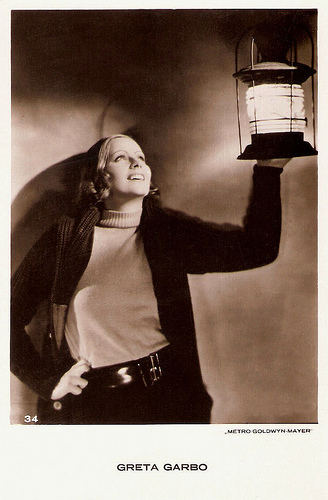
Dutch postcard by JosPe, Arnhem, no. 34. Photo: MGM / Clarence Sinclair Bull. Publicity still for the German version of Anna Christie (Jacques Feyder, 1930).
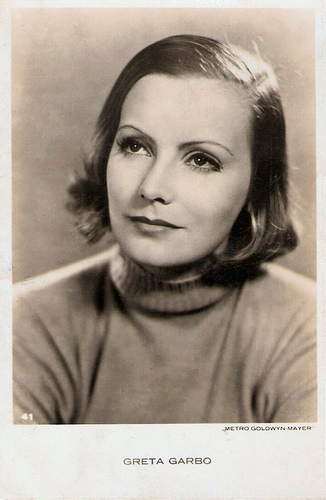
Dutch Postcard, no. 41. Photo: Clarence Sinclair Bull / Metro Goldwyn Mayer. Publicity still for Anna Christie (Clarence Brown, 1930).
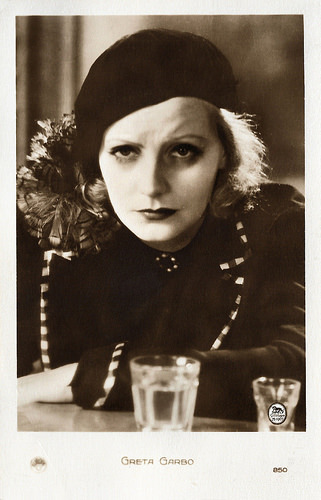
French postcard by Europe, no. 850. Photo: Metro-Goldwyn-Mayer / Clarence Sinclair Bull. Publicity still for the German version of Anna Christie (Jacques Feyder, 1930).
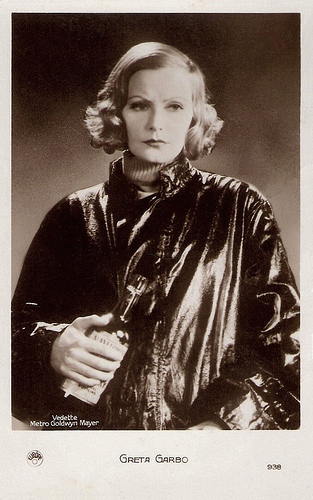
French postcard by Europe, no. 938. Photo: Metro-Goldwyn-Mayer. Publicity still for Anna Christie (Clarence Brown, 1930).
Dark secrets of the past
In Anna Christie (Clarence Brown, 1930), Greta Garbo plays a young woman who reunites with her estranged father Chris (George F. Marion), the alcoholic skipper of a coal barge. When Anna arrives in New York, she is a wounded woman with a hidden dishonourable past since she had worked for two years in a brothel to survive.
Anna moves to the barge to live with her father and one night, Chris rescues the sailor Matt (Charles Bickford) and two other fainted sailors from the sea. Soon Anna and Matt fall in love with each other and Anna has the best days of her life.
But when Matt proposes to marry her, Anna is reluctant and she is also haunted by her past. Matt insists and Anna opens her heart to him and to her father disclosing the dark secrets of her past...
Anna Christie is based on the Broadway play with the same name by Eugene O'Neill. The play opened at the Vanderbilt Theater in New York on 2 November 1921 and ran for 177 performances. George F. Marion and James T. Mack (Johnny) originated their film roles in the play. Marion also starred in the earlier silent film version Anna Christie (John Griffith Wray, 1923), starring Blanche Sweet.
Claudio Carvalho at IMDb : "Anna Christie is the first talkie of Greta Garbo and a heartbreaking story of a young woman that finds redemption through love. I bought the DVD with both versions of 1930 and 1931 [both versions are from 1930, PvY], and the version in English is restored and has additional scenes in the beginning and in the ending; however, Jacques Feyder's version in German is better than Clarence Brown's."
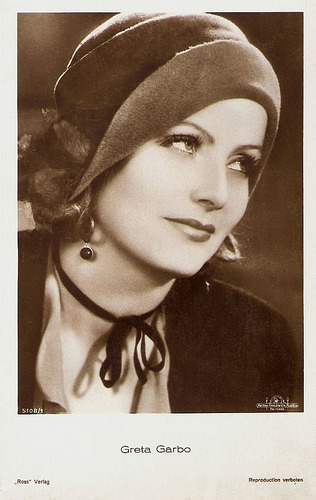
German postcard by Ross Verlag, no. 5108/1, 1930-1931. Photo: Metro-Goldwyn-Mayer / Clarence Sinclair Bull. Publicity still for Anna Christie (Clarence Brown, 1930).
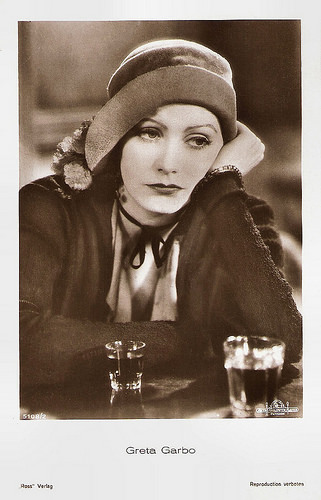
German postcard by Ross Verlag, no. 5108/2, 1930-1931. Photo: MGM / Clarence Sinclair Bull. Publicity still for Anna Christie (Clarence Brown, 1930).
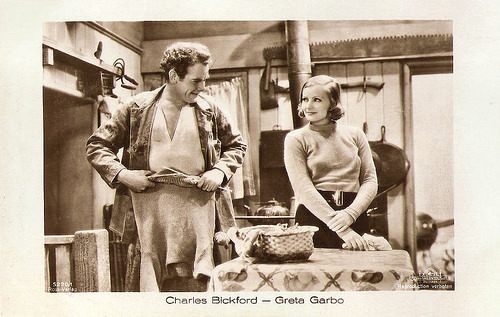
German postcard by Ross Verlag, no. 5290/1, 1930-1931. Photo: MGM. Publicity still for Anna Christie (Clarence Brown, 1930) with Charles Bickford .
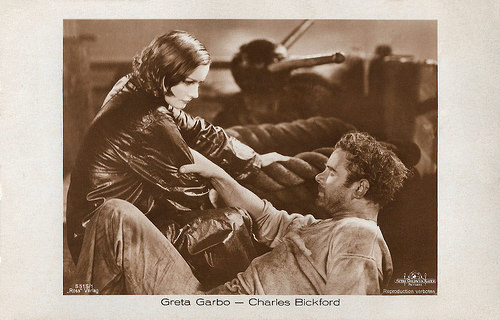
German postcard by Ross Verlag, no. 5515/1. Photo: MGM. Greta Garbo and Charles Bickford in Anna Christie (Clarence Brown, 1930).
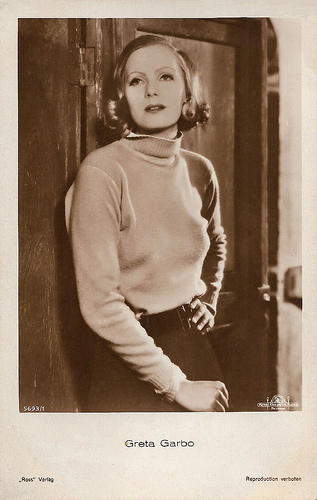
German postcard by Ross Verlag, no. 5693/1. Photo: MGM. Greta Garbo in Anna Christie (Clarence Brown, 1930).
Which version is better?
The German version was produced by Metro-Goldwyn-Mayer at their Culver City, California studio in July and August 1930. The English-language original had been filmed there in October and November 1929.
Garbo is the only cast member in both versions and noticeably differs in her appearance in the two. The German dialogue was written by Walter Hasenclever and Frank Reicher, for the most part very closely following Frances Marion's original adaptation. The film was directed by Jacques Feyder using the same cinematographer, Garbo favourite William H. Daniels, but a different crew.
"It's better in German", writes Lomza Lady at IMDb : "This version is much better than the English-language version: brisker pacing (although very, very slow by modern standards), generally better performances, and even Eugene O'Neill's somewhat ponderous dialogue is rendered more believable in the subtitles.
While Marie Dressler's performance in the English version is fabulous, Salka Viertel's in the German version is also very, very good, just different.
Garbo seems more natural in the German version, perhaps because she was at that time more comfortable speaking German than speaking English. Garbo's acting style may have been a bit old-fashioned, but she was never dull in any film. A true star."
Fernando Silva at IMDb : "The atmosphere of the film seems different from the regular MGM stuff made on that era, it looks very similar to French or German expressionistic films from the thirties, well it was directed by a great French director, Monsieur Jacques Feyder, who had directed Garbo in 1929 in The Kiss.
Theo Shall is excellent and gives an absolutely believable performance as Anna's sweetheart, the hard-boiled, tough, sailor, who's just a kid in man's body. Also Hans Junkermann gives a very fine performance, as Anna's alcoholic father and Salka Viertel too, as a good-hearted old cheap floozy."
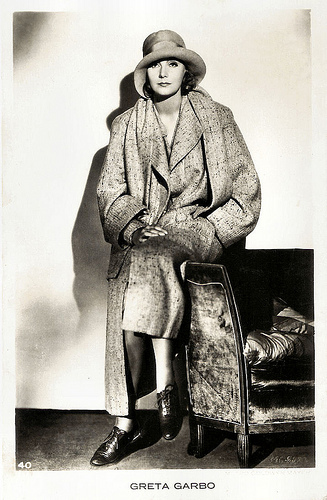
Dutch postcard, no. 40. Photo: Metro-Goldwyn-Mayer. Publicity still for Anna Christie (Clarence Brown, 1930).
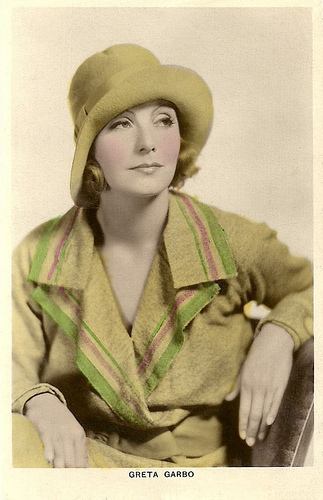
British postcard in the Colourgraph Series, London, no. C 81. Photo: Clarence Sinclair Bull. Publicity still for the German version of Anna Christie (Jacques Feyder, 1930).
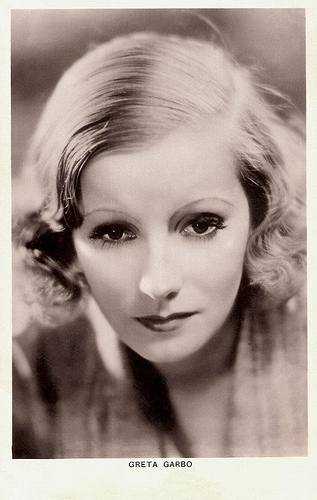
British postcard in the Picturegoer Series, London, no. 283e. Photo: Clarence Sinclair Bull. Publicity still for the German version of Anna Christie (Jacques Feyder, 1930).
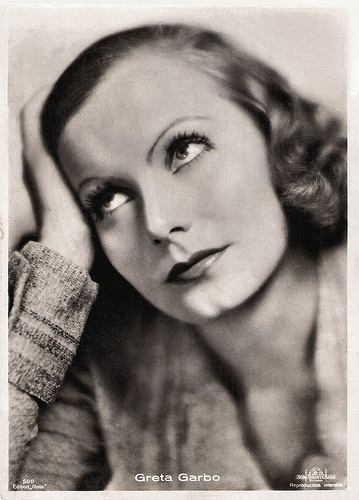
French postcard by Edition Ross, no. 500. Photo: Clarence Sinclair Bull. Publicity still for the German version of Anna Christie (Jacques Feyder, 1930).
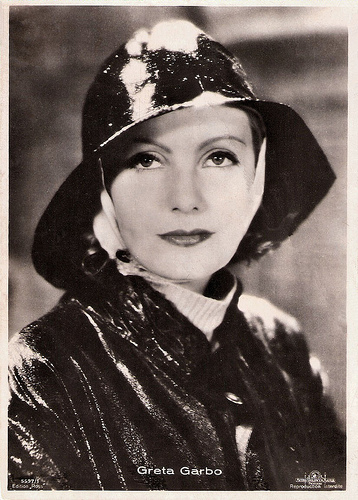
French postcard by Edition Ross, no. 5597/1, 1930-1931. Photo: Metro-Goldwyn-Mayer / Clarence Sinclair Bull. Publicity still for Anna Christie (Jacques Feyder, 1930).
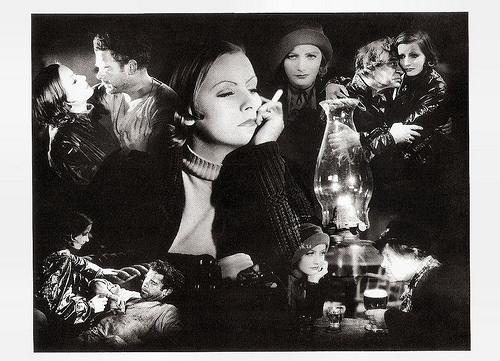
Swiss postcard by News Productions, Baulmes, no. 56490. Photo: Cinémathèque Suisse / Metro-Goldwyn-Mayer. Publicity still for Anna Christie (Clarence Brown, 1930). Design: Clarence Sinclair Bull, 1930.
Sources: Claudio Carvalho (IMDb), Lomza Lady (IMDb), Fernando Silva (IMDb), Wikipedia and IMDb.

Dutch postcard by JosPe, Arnhem, no. 34. Photo: MGM / Clarence Sinclair Bull. Publicity still for the German version of Anna Christie (Jacques Feyder, 1930).

Dutch Postcard, no. 41. Photo: Clarence Sinclair Bull / Metro Goldwyn Mayer. Publicity still for Anna Christie (Clarence Brown, 1930).

French postcard by Europe, no. 850. Photo: Metro-Goldwyn-Mayer / Clarence Sinclair Bull. Publicity still for the German version of Anna Christie (Jacques Feyder, 1930).

French postcard by Europe, no. 938. Photo: Metro-Goldwyn-Mayer. Publicity still for Anna Christie (Clarence Brown, 1930).
Dark secrets of the past
In Anna Christie (Clarence Brown, 1930), Greta Garbo plays a young woman who reunites with her estranged father Chris (George F. Marion), the alcoholic skipper of a coal barge. When Anna arrives in New York, she is a wounded woman with a hidden dishonourable past since she had worked for two years in a brothel to survive.
Anna moves to the barge to live with her father and one night, Chris rescues the sailor Matt (Charles Bickford) and two other fainted sailors from the sea. Soon Anna and Matt fall in love with each other and Anna has the best days of her life.
But when Matt proposes to marry her, Anna is reluctant and she is also haunted by her past. Matt insists and Anna opens her heart to him and to her father disclosing the dark secrets of her past...
Anna Christie is based on the Broadway play with the same name by Eugene O'Neill. The play opened at the Vanderbilt Theater in New York on 2 November 1921 and ran for 177 performances. George F. Marion and James T. Mack (Johnny) originated their film roles in the play. Marion also starred in the earlier silent film version Anna Christie (John Griffith Wray, 1923), starring Blanche Sweet.
Claudio Carvalho at IMDb : "Anna Christie is the first talkie of Greta Garbo and a heartbreaking story of a young woman that finds redemption through love. I bought the DVD with both versions of 1930 and 1931 [both versions are from 1930, PvY], and the version in English is restored and has additional scenes in the beginning and in the ending; however, Jacques Feyder's version in German is better than Clarence Brown's."

German postcard by Ross Verlag, no. 5108/1, 1930-1931. Photo: Metro-Goldwyn-Mayer / Clarence Sinclair Bull. Publicity still for Anna Christie (Clarence Brown, 1930).

German postcard by Ross Verlag, no. 5108/2, 1930-1931. Photo: MGM / Clarence Sinclair Bull. Publicity still for Anna Christie (Clarence Brown, 1930).

German postcard by Ross Verlag, no. 5290/1, 1930-1931. Photo: MGM. Publicity still for Anna Christie (Clarence Brown, 1930) with Charles Bickford .

German postcard by Ross Verlag, no. 5515/1. Photo: MGM. Greta Garbo and Charles Bickford in Anna Christie (Clarence Brown, 1930).

German postcard by Ross Verlag, no. 5693/1. Photo: MGM. Greta Garbo in Anna Christie (Clarence Brown, 1930).
Which version is better?
The German version was produced by Metro-Goldwyn-Mayer at their Culver City, California studio in July and August 1930. The English-language original had been filmed there in October and November 1929.
Garbo is the only cast member in both versions and noticeably differs in her appearance in the two. The German dialogue was written by Walter Hasenclever and Frank Reicher, for the most part very closely following Frances Marion's original adaptation. The film was directed by Jacques Feyder using the same cinematographer, Garbo favourite William H. Daniels, but a different crew.
"It's better in German", writes Lomza Lady at IMDb : "This version is much better than the English-language version: brisker pacing (although very, very slow by modern standards), generally better performances, and even Eugene O'Neill's somewhat ponderous dialogue is rendered more believable in the subtitles.
While Marie Dressler's performance in the English version is fabulous, Salka Viertel's in the German version is also very, very good, just different.
Garbo seems more natural in the German version, perhaps because she was at that time more comfortable speaking German than speaking English. Garbo's acting style may have been a bit old-fashioned, but she was never dull in any film. A true star."
Fernando Silva at IMDb : "The atmosphere of the film seems different from the regular MGM stuff made on that era, it looks very similar to French or German expressionistic films from the thirties, well it was directed by a great French director, Monsieur Jacques Feyder, who had directed Garbo in 1929 in The Kiss.
Theo Shall is excellent and gives an absolutely believable performance as Anna's sweetheart, the hard-boiled, tough, sailor, who's just a kid in man's body. Also Hans Junkermann gives a very fine performance, as Anna's alcoholic father and Salka Viertel too, as a good-hearted old cheap floozy."

Dutch postcard, no. 40. Photo: Metro-Goldwyn-Mayer. Publicity still for Anna Christie (Clarence Brown, 1930).

British postcard in the Colourgraph Series, London, no. C 81. Photo: Clarence Sinclair Bull. Publicity still for the German version of Anna Christie (Jacques Feyder, 1930).

British postcard in the Picturegoer Series, London, no. 283e. Photo: Clarence Sinclair Bull. Publicity still for the German version of Anna Christie (Jacques Feyder, 1930).

French postcard by Edition Ross, no. 500. Photo: Clarence Sinclair Bull. Publicity still for the German version of Anna Christie (Jacques Feyder, 1930).

French postcard by Edition Ross, no. 5597/1, 1930-1931. Photo: Metro-Goldwyn-Mayer / Clarence Sinclair Bull. Publicity still for Anna Christie (Jacques Feyder, 1930).

Swiss postcard by News Productions, Baulmes, no. 56490. Photo: Cinémathèque Suisse / Metro-Goldwyn-Mayer. Publicity still for Anna Christie (Clarence Brown, 1930). Design: Clarence Sinclair Bull, 1930.
Sources: Claudio Carvalho (IMDb), Lomza Lady (IMDb), Fernando Silva (IMDb), Wikipedia and IMDb.
Published on April 10, 2018 22:00
April 9, 2018
Greta Garbo's film partners
Greta Garbo famously never married, but had many lovers on screen. We selected twelve postcards with her film partners for today's post. Her favourite co-star was John Gilbert, who was her love interest in Flesh and the Devil (Clarence Brown, 1926), Love (Edmund Goulding, 1927), Woman of Affairs (Clarence Brown, 1928) and Queen Christina (Rouben Mamoulian, 1933) In reality, Garbo left Gilbert standing at the altar in 1927 when she got cold feet about marrying him.
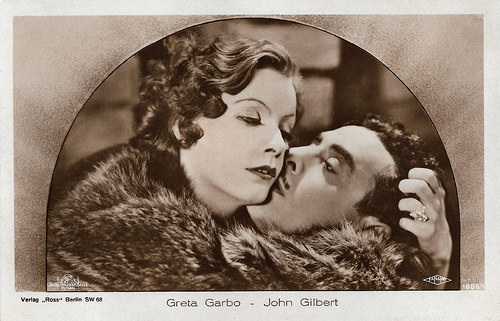
John Gilbert. German postcard by Ross Verlag, no. 1886/1, 1927-1928. Photo: Clarence Sinclair Bull / Metro-Goldwyn-Mayer. Publicity still for Flesh and the Devil (Clarence Brown, 1926).
In Flesh and the Devil, John Gilbert and Lars Hanson are lifelong friends who fall in love with the same woman ( Greta Garbo ). Gilbert's more passionate, hot-blooded character forms a believable and interesting contrast to Hanson's innocently earnest portrayal of his loyal, unsuspecting friend. Garbo makes what could have been a stereotyped love interest into a complex and sometimes tormented character.
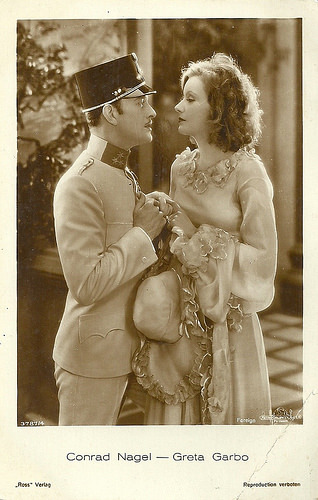
Conrad Nagel. German postcard by Ross Verlag, Foreign, no. 3787/4, 1928-1929. Photo: Metro-Goldwyn-Mayer. Publicity still for The Mysterious Lady (1928).
Garbo plays in The Mysterious Lady an attractive Russian spy, who seduces an Austrian officer (Nagel) in order to get some important plans. But she actually falls in love with him, and both are placed in a dangerous situation.
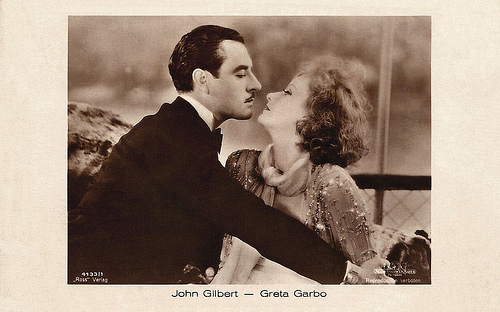
John Gilbert. German postcard by Ross Verlag, no. 4133/1. Photo: MGM. Publicity still for A Woman of Affairs (Clarence Brown, 1928).
When childhood sweethearts Diana (Garbo) and Nevs (Gilbert) are kept from marrying in A Woman of Affairs, she finally marries another. While Nevs still loves Diana, she does not return to England for seven years - just 3 days before Nevs' wedding to Constance.
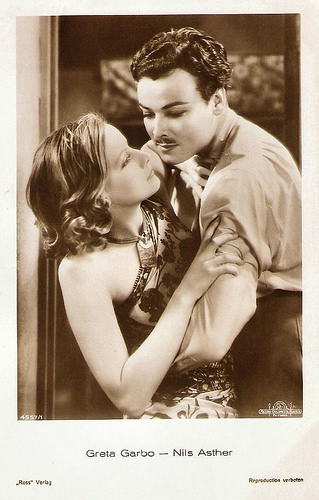
Nils Asther . German postcard by Ross Verlag, no. 4557/1, 1928-1929. Photo: Metro-Goldwyn-Mayer. Publicity still for Wild Orchids (Sidney Franklin, 1929).
In Wild Orchids, 50ish John Sterling (Lewis Stone) and his young wife, Lillie (Garbo) embark on a cruise to Java. The Javanese Prince De Gace (Asther) tries to seduce her, but he's discovered by Sterling. What will he do about it?
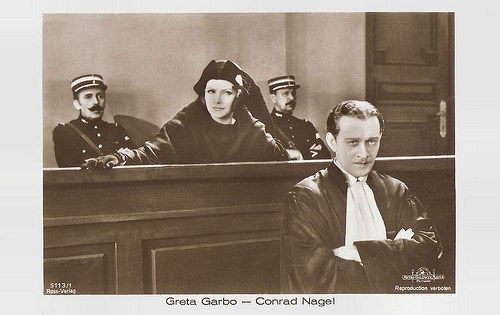
Conrad Nagel. German postcard by Ross Verlag, no. 5113/1, 1930-1931. Photo: Metro-Goldwyn-Mayer (MGM). Publicity still for The Kiss (Jacques Feyder, 1929).
In Greta Garbo 's last silent film, Nagel plays her lawyer, who defends her in court after her ailing and financially distraught husband is shot. But he is also her former lover.
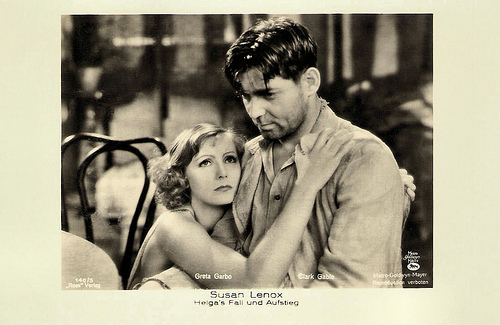
Clark Gable. German postcard by Ross Verlag, no. 140/5. Photo: Metro-Goldwyn-Mayer. Publicity still for Susan Lenox (Robert Z. Leonard, 1931).
Fleeing her cruel uncle and an arranged marriage Susan Lenox (Garbo) falls in love with a kind stranger, the architect Rodney (Gable) but circumstances force her to become a woman of easy virtue. This was Gable's first starring role and he fared well, but he and Garbo disliked each other. She thought his acting was wooden while he considered her a snob.
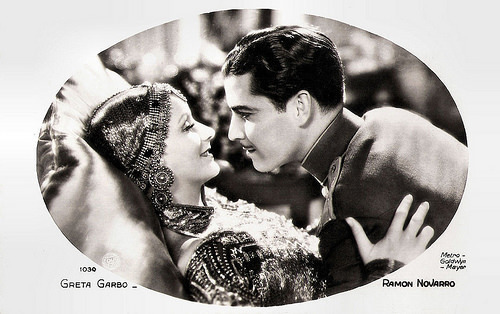
Ramon Novarro . French postcard by EDUG, no. 1030. Photo: Clarence Sinclair Bull / Metro-Goldwyn-Mayer. Publicity still for Mata Hari (George Fitzmaurice, 1931).
During World War I, Mata Hari (Garbo) is a German spy, working in Paris. She has already seduced the Russian general Shubin (Lionel Barrymore), and has now set her eyes on lieutenant Rosanov (Novarro), a young up-and-coming officer. In order to get her hand on secret documents in his possession, she spends a night with him.
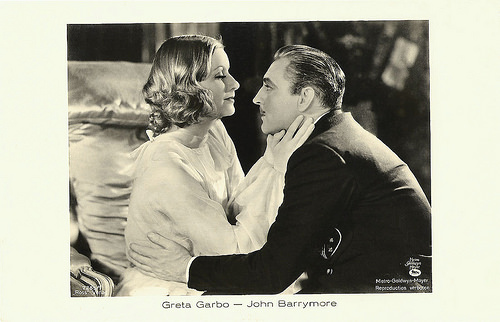
John Barrymore. German postcard by Ross Verlag, no. 7285/1, 1932-1933. Photo: Metro-Goldwyn-Mayer. Publicity still for Grand Hotel (Edmund Goulding, 1932).
Barrymore plays Baron von Geigern, who is broke and trying to steal eccentric dancer Grusinskaya's (Garbo) pearls. He ends up stealing her heart instead.
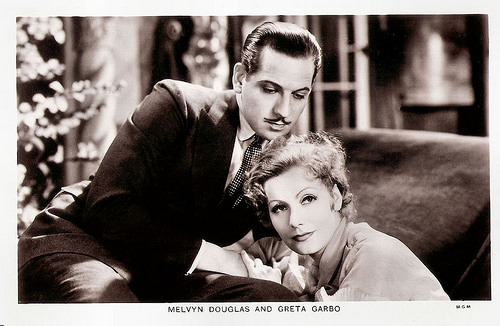
Melvyn Douglas. British postcard in the Film Partners series, no. P 82. Photo: MGM. Publicity still for As You Desire Me (Rouben Mamoulian, 1932).
Is Budapest bar entertainer Zara (Garbo) actually Maria, the wife of Bruno (Douglas), an officer in the Italian army? Was her memory destroyed during a World War I invasion ten years earlier? Everyone on Bruno's estate is desperately searching for the truth.
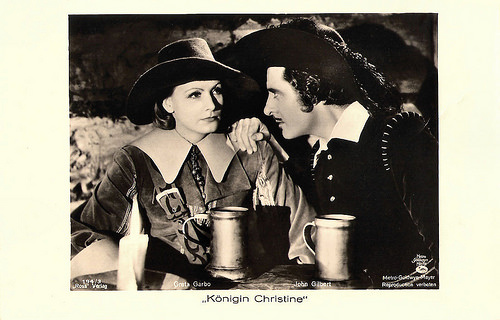
John Gilbert. German postcard by Ross Verlag, no. 194/3. Photo: MGM. Publicity still for Queen Christina (Rouben Mamoulian, 1933).
Queen Christina (Garbo) accidentally and secretly falls in love with an emissary from Spain (Gilbert), but a marriage between the two seems out of the question. She must choose between the throne and the man she loves. Queen Christina reunited Garbo with her favourite leading man from her silent days, John Gilbert, and the two are again marvelous together.
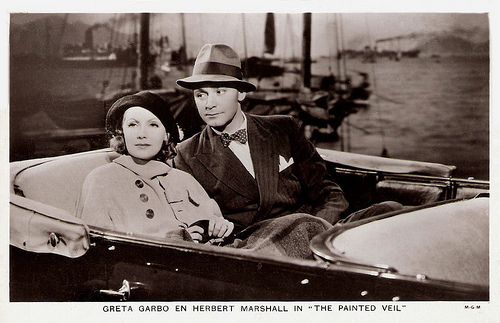
Herbert Marshall. Dutch postcard by M. Bonnist & Zonen, Amsterdam, no. B 422. Photo: MGM. Publicity still for The Painted Veil (Richard Boleslawski, 1934).
Garbo plays in The Painted Veil a wife neglected by her husband (Marshall), a medical researcher in China. She falls in love with a dashing diplomatic attache (George Brent). When it is discovered by her husband he becomes very bitter. But while fighting a cholera epidemic the couple grows closer together than ever.
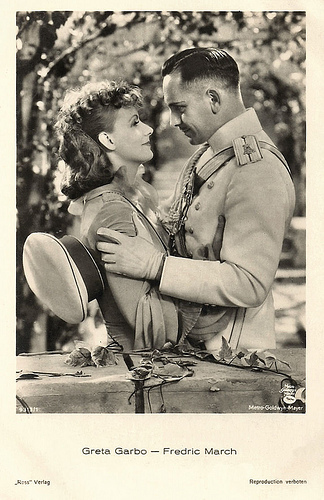
Fredric March. German postcard by Ross Verlag, no. 9313/1. Photo: MGM. Publicity still for Anna Karenina (Clarence Brown, 1935).
In this adaptation of Leo Tolstoy's famous novel, the married Anna Karenina (Garbo) falls in love with Count Vronsky (March). Her husband (Basil Rathbone) refuses to grant a divorce, and both lovers must contend with the social repercussions.
Source: .

John Gilbert. German postcard by Ross Verlag, no. 1886/1, 1927-1928. Photo: Clarence Sinclair Bull / Metro-Goldwyn-Mayer. Publicity still for Flesh and the Devil (Clarence Brown, 1926).
In Flesh and the Devil, John Gilbert and Lars Hanson are lifelong friends who fall in love with the same woman ( Greta Garbo ). Gilbert's more passionate, hot-blooded character forms a believable and interesting contrast to Hanson's innocently earnest portrayal of his loyal, unsuspecting friend. Garbo makes what could have been a stereotyped love interest into a complex and sometimes tormented character.

Conrad Nagel. German postcard by Ross Verlag, Foreign, no. 3787/4, 1928-1929. Photo: Metro-Goldwyn-Mayer. Publicity still for The Mysterious Lady (1928).
Garbo plays in The Mysterious Lady an attractive Russian spy, who seduces an Austrian officer (Nagel) in order to get some important plans. But she actually falls in love with him, and both are placed in a dangerous situation.

John Gilbert. German postcard by Ross Verlag, no. 4133/1. Photo: MGM. Publicity still for A Woman of Affairs (Clarence Brown, 1928).
When childhood sweethearts Diana (Garbo) and Nevs (Gilbert) are kept from marrying in A Woman of Affairs, she finally marries another. While Nevs still loves Diana, she does not return to England for seven years - just 3 days before Nevs' wedding to Constance.

Nils Asther . German postcard by Ross Verlag, no. 4557/1, 1928-1929. Photo: Metro-Goldwyn-Mayer. Publicity still for Wild Orchids (Sidney Franklin, 1929).
In Wild Orchids, 50ish John Sterling (Lewis Stone) and his young wife, Lillie (Garbo) embark on a cruise to Java. The Javanese Prince De Gace (Asther) tries to seduce her, but he's discovered by Sterling. What will he do about it?

Conrad Nagel. German postcard by Ross Verlag, no. 5113/1, 1930-1931. Photo: Metro-Goldwyn-Mayer (MGM). Publicity still for The Kiss (Jacques Feyder, 1929).
In Greta Garbo 's last silent film, Nagel plays her lawyer, who defends her in court after her ailing and financially distraught husband is shot. But he is also her former lover.

Clark Gable. German postcard by Ross Verlag, no. 140/5. Photo: Metro-Goldwyn-Mayer. Publicity still for Susan Lenox (Robert Z. Leonard, 1931).
Fleeing her cruel uncle and an arranged marriage Susan Lenox (Garbo) falls in love with a kind stranger, the architect Rodney (Gable) but circumstances force her to become a woman of easy virtue. This was Gable's first starring role and he fared well, but he and Garbo disliked each other. She thought his acting was wooden while he considered her a snob.

Ramon Novarro . French postcard by EDUG, no. 1030. Photo: Clarence Sinclair Bull / Metro-Goldwyn-Mayer. Publicity still for Mata Hari (George Fitzmaurice, 1931).
During World War I, Mata Hari (Garbo) is a German spy, working in Paris. She has already seduced the Russian general Shubin (Lionel Barrymore), and has now set her eyes on lieutenant Rosanov (Novarro), a young up-and-coming officer. In order to get her hand on secret documents in his possession, she spends a night with him.

John Barrymore. German postcard by Ross Verlag, no. 7285/1, 1932-1933. Photo: Metro-Goldwyn-Mayer. Publicity still for Grand Hotel (Edmund Goulding, 1932).
Barrymore plays Baron von Geigern, who is broke and trying to steal eccentric dancer Grusinskaya's (Garbo) pearls. He ends up stealing her heart instead.

Melvyn Douglas. British postcard in the Film Partners series, no. P 82. Photo: MGM. Publicity still for As You Desire Me (Rouben Mamoulian, 1932).
Is Budapest bar entertainer Zara (Garbo) actually Maria, the wife of Bruno (Douglas), an officer in the Italian army? Was her memory destroyed during a World War I invasion ten years earlier? Everyone on Bruno's estate is desperately searching for the truth.

John Gilbert. German postcard by Ross Verlag, no. 194/3. Photo: MGM. Publicity still for Queen Christina (Rouben Mamoulian, 1933).
Queen Christina (Garbo) accidentally and secretly falls in love with an emissary from Spain (Gilbert), but a marriage between the two seems out of the question. She must choose between the throne and the man she loves. Queen Christina reunited Garbo with her favourite leading man from her silent days, John Gilbert, and the two are again marvelous together.

Herbert Marshall. Dutch postcard by M. Bonnist & Zonen, Amsterdam, no. B 422. Photo: MGM. Publicity still for The Painted Veil (Richard Boleslawski, 1934).
Garbo plays in The Painted Veil a wife neglected by her husband (Marshall), a medical researcher in China. She falls in love with a dashing diplomatic attache (George Brent). When it is discovered by her husband he becomes very bitter. But while fighting a cholera epidemic the couple grows closer together than ever.

Fredric March. German postcard by Ross Verlag, no. 9313/1. Photo: MGM. Publicity still for Anna Karenina (Clarence Brown, 1935).
In this adaptation of Leo Tolstoy's famous novel, the married Anna Karenina (Garbo) falls in love with Count Vronsky (March). Her husband (Basil Rathbone) refuses to grant a divorce, and both lovers must contend with the social repercussions.
Source: .
Published on April 09, 2018 22:00
April 8, 2018
Silent Garbo
Her triumph with Anna Christie (1930) turned Greta Garbo into one of the brightest MGM stars of the early sound period. Throughout the 1930s, she remained one of Hollywood's idols with her performances as Mata Hari, Queen Christina, Anna Karenina, Camille and Ninotschka. But the silent films Garbo made in Sweden, Berlin and Hollywood are at least as interesting.
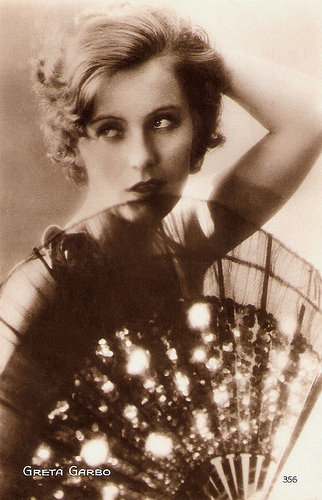
French postcard by Cinémagazine-Edition (CE), Paris, no. 356.
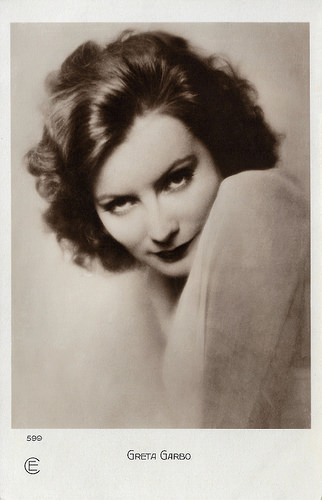
French postcard by Cinémagazine-Edition (CE), Paris, no. 599.
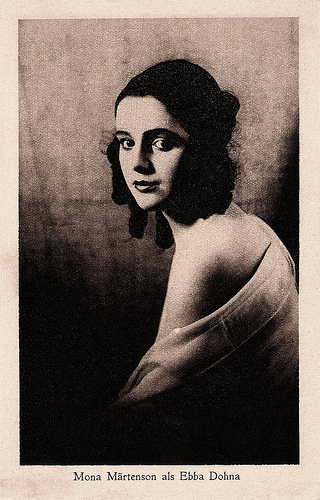
German postcard by Trianon-Film, 1924. Photo: Svenska-Film. Publicity still for Gösta Berlings saga/The Atonement of Gosta Berling (Mauritz Stiller, 1924).
In 1924 Greta Garbo had her big breakthrough when famed director Mauritz Stiller gave her a part in his film Gösta Berlings Saga/The Atonement of Gosta Berling (1924). We have no postcard of Garbo in this film, but we do have this one from her co-star Mona Mårtenson , who played her sister Ebba Dolma in the film.
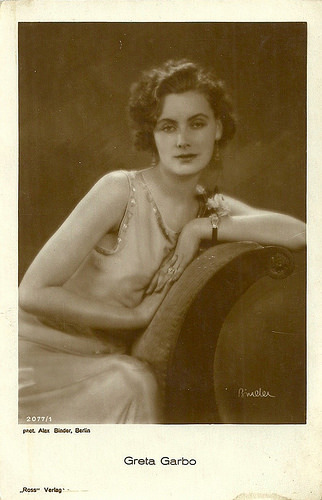
German postcard by Ross Verlag, no. 2077/1, 1927-1928. Photo: Alex Binder, Berlin.
After Gösta Berlings Saga and before going to Hollywood, Garbo starred in the German film Die freudlose Gasse/The Joyless Street (1925) by Georg Wilhelm Pabst. Berlin-based photographer Alex Binder of Atelier Binder made the picture above during the shooting of Die freudlose Gasse in 1924.
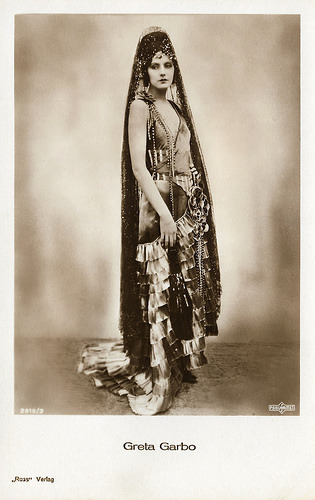
German postcard by Ross Verlag, no. 2010/2, 1927-1928. Photo: Parufamet. Publicity still for Torrent (Monta Bell, 1926).
Following Die freudlose Gasse (1925) both Greta Garbo and her friend and mentor Mauritz Stiller were offered contracts with MGM. Her first film for the studio was the silent production Torrent (1926).
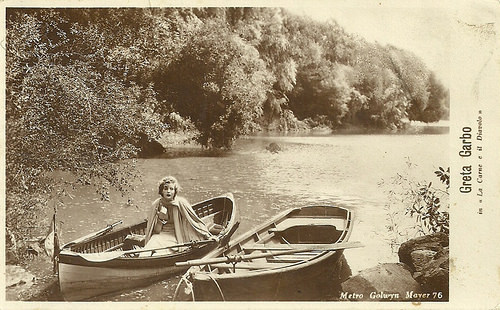
Italian postcard, no. 76. Photo: Metro-Goldwyn-Mayer. Greta Garbo in Flesh and the Devil (Clarence Brown, 1926).
Reportedly, the first scene in Flesh and the Devil between John Gilbert and Greta Garbo in the train station was also the first time Gilbert ever saw Garbo. He falls in love on camera, so completely in love that he never went back home to his wife.
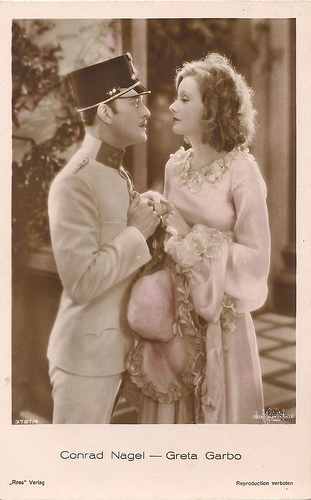
German postcard by Ross Verlag, Foreign, no. 3787/4, 1928-1929. Photo: Metro-Goldwyn-Mayer. Publicity still for The Mysterious Lady (Fred Niblo, 1928) with Conrad Nagel. Collection: Joanna.
We love the taglines for this film: "No man knew what she really was. And no man could resist her exotic beauty. A famous Russian spy, moving through the lives of men, in a maze of intrigue, passion and love."
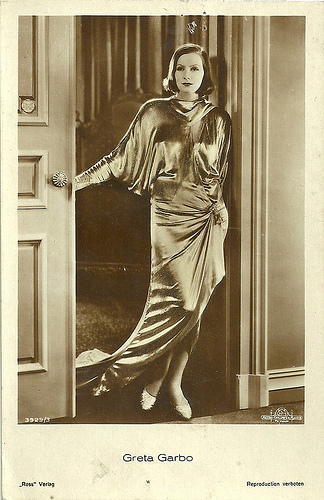
German postcard by Ross Verlag, no. 3929/3, 1928-1929. Photo: Metro-Goldwyn-Mayer.
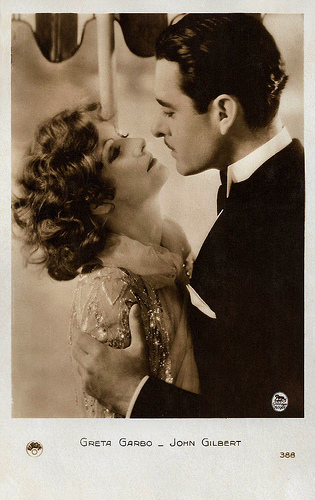
French postcard by Europe, no. 388, distributed in Italy by Casa Editrice Ballerini & Fratini, Firenze. Photo: James Manatt / Metro-Goldwyn-Mayer. Publicity still for A Woman of Affairs (Clarence Brown, 1928).
"Garbo had something behind the eyes that you couldn't see until you photographed her in close-up. You could see thought. If she had to look at one person with jealousy, and another with love, she didn't have to change the expression. You could see it in her eyes as she looked from one to the other. And nobody else could do that on the screen." (director Clarence Brown in a 1968 interview).
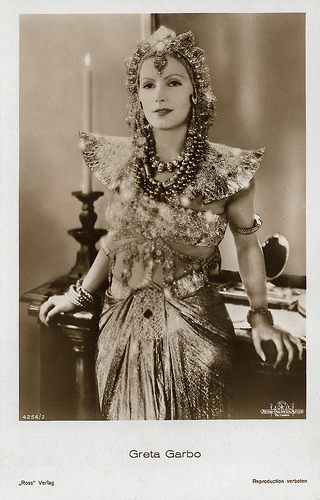
German postcard by Ross Verlag, no. 4256/2, 1929-1930. Photo: Metro-Goldwyn-Mayer. Publicity still for Wild Orchids (Sidney Franklin, 1929).
During the production of Wild Orchids, Mauritz Stiller died in Sweden. Devastated by his death, Garbo travelled to Stockholm incognito to mourn his death. Her secretive travel plans were quickly foiled when she was recognised on the voyage.
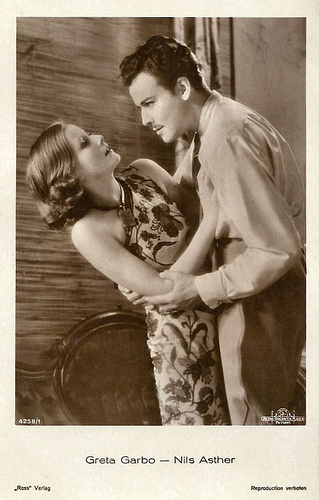
German postcard by Ross Verlag, no. 4258/1, 1929-1930. Photo: Metro-Goldwyn-Mayer. Publicity still for Wild Orchids (Sidney Franklin, 1929) with Nils Asther .
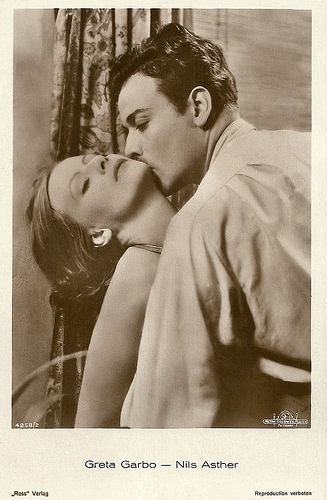
German postcard by Ross Verlag, no. 4258/2, 1929-1930. Photo: Metro-Goldwyn-Mayer. Greta Garbo and Nils Asther in the late silent film Wild Orchids (Sidney Franklin, 1929).
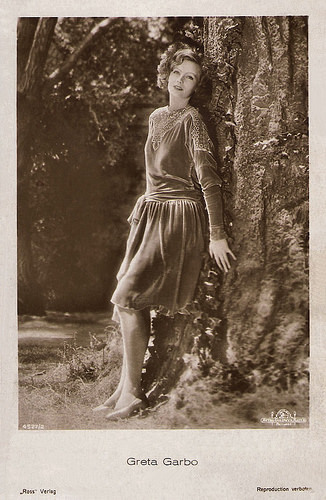
German postcard by Ross Verlag, no. 4527/2, 1929-1930. Photo: Clarence Bull / Metro-Goldwyn-Mayer.
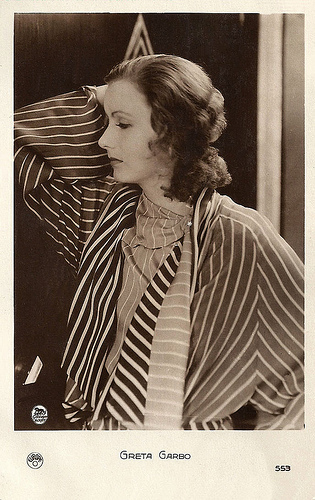
French postcard by Europe, no. 553. Photo: Ruth Harriet Louise / Metro-Goldwyn-Mayer. Publicity still for The Single Standard (John S. Robertson, 1929). Gown by Adrian.
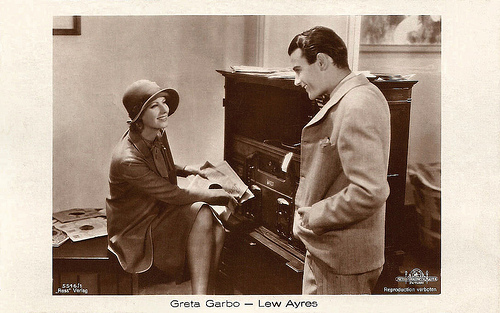
German postcard by Ross Verlag, no. 5516/1, 1930-1931. Photo: Metro-Goldwyn-Mayer (MGM).
Lew Ayres co-starred with Garbo in her last silent film The Kiss (1929), directed by Belgium born director Jacques Feyder and scripted by German screenwriter Hanns Kräly. After this successful film, Feyder directed Garbo again in the German language version of Anna Christie (1930) and then returned to France. There he produced his greatest achievements: Le Grand Jeu (1934), Pension Mimosas (1935) and La Kermesse Héroique/Carnival in Flanders (1935).
Sources: Garbo Forever and .

French postcard by Cinémagazine-Edition (CE), Paris, no. 356.

French postcard by Cinémagazine-Edition (CE), Paris, no. 599.

German postcard by Trianon-Film, 1924. Photo: Svenska-Film. Publicity still for Gösta Berlings saga/The Atonement of Gosta Berling (Mauritz Stiller, 1924).
In 1924 Greta Garbo had her big breakthrough when famed director Mauritz Stiller gave her a part in his film Gösta Berlings Saga/The Atonement of Gosta Berling (1924). We have no postcard of Garbo in this film, but we do have this one from her co-star Mona Mårtenson , who played her sister Ebba Dolma in the film.

German postcard by Ross Verlag, no. 2077/1, 1927-1928. Photo: Alex Binder, Berlin.
After Gösta Berlings Saga and before going to Hollywood, Garbo starred in the German film Die freudlose Gasse/The Joyless Street (1925) by Georg Wilhelm Pabst. Berlin-based photographer Alex Binder of Atelier Binder made the picture above during the shooting of Die freudlose Gasse in 1924.

German postcard by Ross Verlag, no. 2010/2, 1927-1928. Photo: Parufamet. Publicity still for Torrent (Monta Bell, 1926).
Following Die freudlose Gasse (1925) both Greta Garbo and her friend and mentor Mauritz Stiller were offered contracts with MGM. Her first film for the studio was the silent production Torrent (1926).

Italian postcard, no. 76. Photo: Metro-Goldwyn-Mayer. Greta Garbo in Flesh and the Devil (Clarence Brown, 1926).
Reportedly, the first scene in Flesh and the Devil between John Gilbert and Greta Garbo in the train station was also the first time Gilbert ever saw Garbo. He falls in love on camera, so completely in love that he never went back home to his wife.

German postcard by Ross Verlag, Foreign, no. 3787/4, 1928-1929. Photo: Metro-Goldwyn-Mayer. Publicity still for The Mysterious Lady (Fred Niblo, 1928) with Conrad Nagel. Collection: Joanna.
We love the taglines for this film: "No man knew what she really was. And no man could resist her exotic beauty. A famous Russian spy, moving through the lives of men, in a maze of intrigue, passion and love."

German postcard by Ross Verlag, no. 3929/3, 1928-1929. Photo: Metro-Goldwyn-Mayer.

French postcard by Europe, no. 388, distributed in Italy by Casa Editrice Ballerini & Fratini, Firenze. Photo: James Manatt / Metro-Goldwyn-Mayer. Publicity still for A Woman of Affairs (Clarence Brown, 1928).
"Garbo had something behind the eyes that you couldn't see until you photographed her in close-up. You could see thought. If she had to look at one person with jealousy, and another with love, she didn't have to change the expression. You could see it in her eyes as she looked from one to the other. And nobody else could do that on the screen." (director Clarence Brown in a 1968 interview).

German postcard by Ross Verlag, no. 4256/2, 1929-1930. Photo: Metro-Goldwyn-Mayer. Publicity still for Wild Orchids (Sidney Franklin, 1929).
During the production of Wild Orchids, Mauritz Stiller died in Sweden. Devastated by his death, Garbo travelled to Stockholm incognito to mourn his death. Her secretive travel plans were quickly foiled when she was recognised on the voyage.

German postcard by Ross Verlag, no. 4258/1, 1929-1930. Photo: Metro-Goldwyn-Mayer. Publicity still for Wild Orchids (Sidney Franklin, 1929) with Nils Asther .

German postcard by Ross Verlag, no. 4258/2, 1929-1930. Photo: Metro-Goldwyn-Mayer. Greta Garbo and Nils Asther in the late silent film Wild Orchids (Sidney Franklin, 1929).

German postcard by Ross Verlag, no. 4527/2, 1929-1930. Photo: Clarence Bull / Metro-Goldwyn-Mayer.

French postcard by Europe, no. 553. Photo: Ruth Harriet Louise / Metro-Goldwyn-Mayer. Publicity still for The Single Standard (John S. Robertson, 1929). Gown by Adrian.

German postcard by Ross Verlag, no. 5516/1, 1930-1931. Photo: Metro-Goldwyn-Mayer (MGM).
Lew Ayres co-starred with Garbo in her last silent film The Kiss (1929), directed by Belgium born director Jacques Feyder and scripted by German screenwriter Hanns Kräly. After this successful film, Feyder directed Garbo again in the German language version of Anna Christie (1930) and then returned to France. There he produced his greatest achievements: Le Grand Jeu (1934), Pension Mimosas (1935) and La Kermesse Héroique/Carnival in Flanders (1935).
Sources: Garbo Forever and .
Published on April 08, 2018 22:00
April 7, 2018
Greta Garbo
On 15 April, it will be 28 years ago that the Great Garbo passed away. Swedish-born Greta Garbo (1905-1990) was one of the greatest and most glamorous film stars ever produced by the Hollywood studio system. She was part of the Golden Age of the silent cinema of the 1920s and was one of the few actors who made a glorious transition to the talkies. She started her career in the European cinema and would always stay more popular in Europe than in the US. She was 84 when she died on 15 April 1990 in New York. Till the 15th, EFSP salutes her and we will only post her postcards.

British postcard in the Picturegoer Series, London, no. 283e.

British postcard in the Picturegoer Series, London, no. 283b.
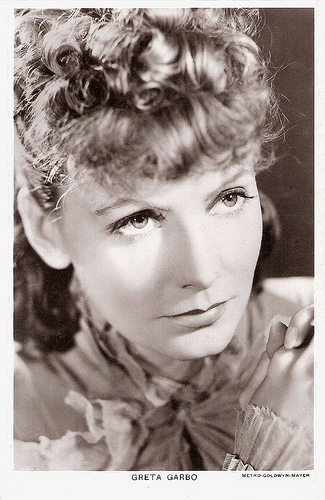
British postcard in the Picturegoer Series, London, no. 637b. Photo: Clarence Sinclair Bull / Metro-Goldwyn-Mayer. Publicity still for Anna Karenina (Clarence Brown, 1935).
Department Store Clerk
Greta Garbo was born as Greta Lovisa Gustafsson in Stockholm in 1905. Her parents were Anna Lovisa (Johansdotter), who worked at a jam factory, and Karl Alfred Gustafsson, a labourer. She had an older sister and brother, Alva and Sven. They grew up in a rundown Stockholm district.
Few who knew Greta in her formative years would have predicted the illustrious career that awaited her. In school, she did little to distinguish herself; nor was her first job, as a barbershop lather girl, indicative of future greatness.
Her father died when she was 14, leaving the family destitute. Greta was forced to leave school and to work as a clerk in the PUB department store, where she also would model for newspaper ads.
She photographed beautifully. Her first film aspirations came when she appeared in two short film advertisements, Herr och fru Stockholm/Mr. and Mrs. Stockholm (Ragnar Ring, 1920) and Konsum Stockholm Promo/How Not to Dress (Ragnar Ring, 1921), both were financed by PUB.
Greta also appeared in a one reel film for a local bakery. The films were seen by director Erik Arthur Petschler who gave her a small part as a bathing beauty in his comedy Luffar-Petter/Peter the Tramp (Erik A. Petschler, 1922).

British postcard in the Colourgraph Series, London, no. C 81. Photo: publicity still for Anna Christie (Clarence Brown, 1930).
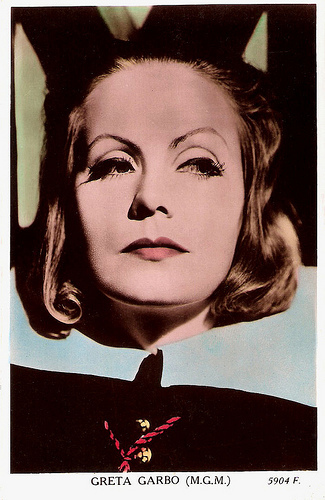
British postcard in the Valentine's Postcard series, no. 5904 F. Photo: MGM. Publicity still for Queen Christina (Rouben Mamoulian, 1933).
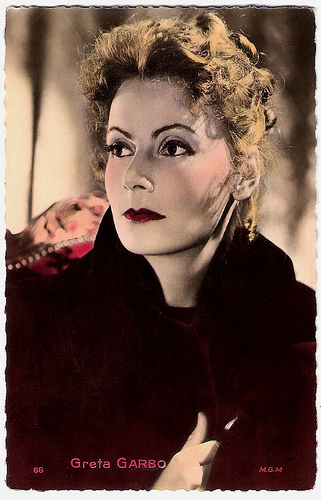
French postcard by Ed. Chantal, no. 66. Photo: M.G.M. Publicity still for Conquest (Clarence Brown, 1937).
Minor Star
Greta Gustafson garnered a couple of good trade reviews. It made her confident enough to seek out and win a scholarship to Dramaten, the prestigious Royal Dramatic Theatre in Stockholm. While studying acting there, she appeared in the historical film En lyckoriddare/A Happy Knight (John W. Brunius, 1921) which features Gösta Ekman as the dashing rogue who steals the heart of the ethereal Mary Johnson. Greta played a maid.
Then she met Mauritz Stiller, one of Sweden's foremost film directors in the early 1920s. Stiller trained the 18-years old in cinema acting technique and gave her the stage name Greta Garbo. He cast her in a major role opposite Lars Hanson in Gösta Berlings Saga/The Legend of Gosta Berling (Mauritz Stiller, 1924). The epic drama was based on a novel by Nobel Prize winner Selma Lagerlöf.
Gösta Berlings Sagawas internationally successful and made Greta a minor star. On the strength of this role, she was cast in the German prostitution and depression melodrama Die Freudlose Gasse/The Joyless Street (G.W. Pabst, 1925), in which she co-starred with the Danish screen legend Asta Nielsen .
And then Hollywood called. Louis B. Mayer invited Stiller to work for MGM when Gösta Berlings Saga caught his attention. On viewing the film, Mayer admired Stiller's direction, but was not impressed with Garbo's acting and screen presence.
Mauritz Stiller insisted on bringing his protégé to Hollywood, thus, Mayer contracted her as well. Later, Garbo’s relationship with Stiller came to an end as her fame in Hollywood grew and he struggled in the studio system. In 1928 Stiller was abruptly fired from directing Garbo's second MGM film, The Temptress (1926), after repeated arguments with studio execs. Stiller returned to Sweden, where he died soon after. He was only 45 and reportedly, Garbo was devastated.

French postcard by Edition Ross, no. 5597/1, 1930-1931. Photo: Metro-Goldwyn-Mayer. Publicity still for Anna Christie (Clarence Brown, 1930).
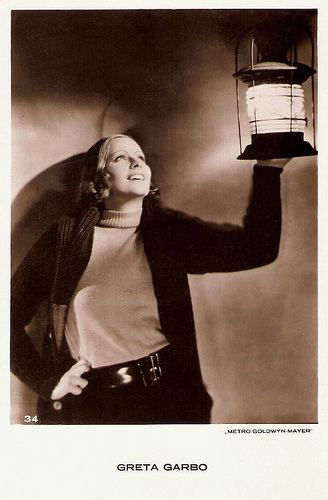
Dutch postcard by JosPe, Arnhem, no. 34. Photo: Clarence Sinclair Bull / Metro Goldwyn Mayer. Publicity still for Anna Christie (Clarence Brown, 1930).

Dutch Postcard, no. 41. Photo: Clarence Sinclair Bull / Metro Goldwyn Mayer. Publicity still for Anna Christie (Clarence Brown, 1930).
Garbo Talks!
In Hollywood, Greta Garbo spent most of 1925 posing for nonsensical publicity photos which endeavored to create a 'mystery woman image for her. Hal Erickson at AllMovie : " but it was only after shooting commenced on Garbo's first American film, The Torrent (1926), that MGM realized it had a potential gold mine on its hands." Director of The Torrent was Monta Bell and Greta played a peasant girl turned singer opposite Ricardo Cortez. The film was a hit and despite its cool reception by the trade press, Garbo's performance was critically acclaimed.
Her third film for MGM, Flesh and the Devil (Clarence Brown, 1926), made her an international star. Her co-star was John Gilbert, and their on-screen chemistry soon translated into an off-camera romance and by the end of the production, they lived together. The Garbo/Gilbert team went on to make an adaptation of Tolstoy's Anna Karenina titled Love (Edmund Goulding, 1927). The couple planned to marry, but Garbo, in one of her attacks of self-imposed solitude, did not show up for the wedding. Over the years, the actress would have other romantic involvements, but would never marry.
Anna Christie (Clarence Brown, 1930) was filmed at a time of transition in Hollywood from the silent era to sound. Reportedly MGM had concerns about Garbo's voice. The studio was afraid that her thick Swedish accent would not register well in the talkies. Poster for her first sound film read "Garbo Talks!", which would become a catchphrase widely associated with her.
Sixteen minutes into Anna Christie, Garbo finally utters her first, now famous line, "Gimme a whiskey, ginger ale on the side, and don't be stingy, baby." Garbo's voice meshed perfectly with her established image, and her performance in Anna Christie was effective. So, when 'Garbo talks' the audience still listened.
Anna Christie, based on a play by Eugene O'Neill, became a transitional film for Garbo. Hal Erickson: "the advent of talkies obliged the actress to drop the 'mysterious temptress' characterization she'd used in silents in favor of more richly textured performances as worldly, somewhat melancholy women to whom the normal pleasures of love and contentment would always be just out of reach."
Greta Garbo had a huge following in Europe, especially in Germany. Therefor MGM also made a German version of Anna Christie. Both versions were filmed back to back. Garbo played the leading role in both versions, but all the other characters in the German version were played by different actors from the English version. Curiously, Garbo herself supposedly favoured her Anna Christie in the German version over the English version. The German version was directed by Jacques Feyder and had its first screening in Germany in 1931.
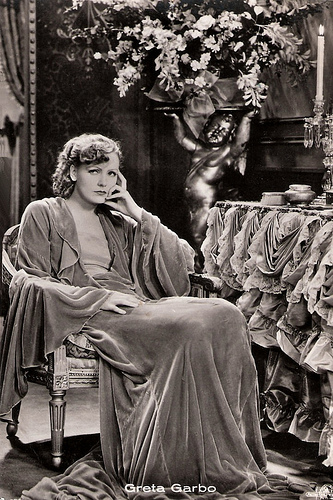
Dutch postcard. Sent by mail in 1931. Photo: Metro-Goldwyn-Mayer.
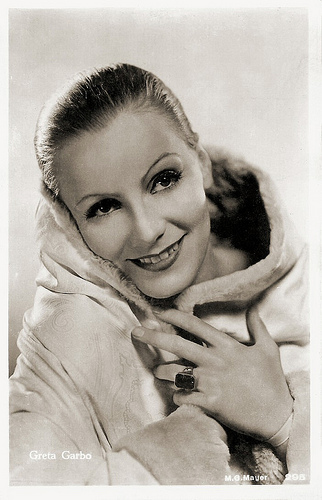
Dutch postcard by JosPe, no. 295. Photo: Metro-Goldwyn-Mayer (MGM) / Clarence Sinclair Bull. Publicity still for Mata Hari (George Fitzmaurice, 1931) .

French postcard by Edition Ross, no. 500. Photo: Clarence Sinclair Bull. Publicity still for the German version of Anna Christie (Jacques Feyder, 1930).
From the Greatest Money-making Machine to Box Office Poison
Greta Garbo next made Romance (Clarence Brown, 1930) in the same year as Anna Christie. Romance is a film with nearly no plot twists, but Garbo is stunning. She originally wanted Gary Cooper as her leading man, but MGM could not borrow Cooper from Paramount, so Garbo had to settle for Lewis Stone and the unknown Gavin Gordon. After Anna Christie, Romance (1930) was somewhat of a letdown, but for her performances in these films she received the first of three Academy Award nominations for Best Actress. Academy rules at the time allowed for a performer to receive a single nomination for their work in more than one film.
In 1931, Garbo bounced back, landing another lead role opposite Ramon Novarro as the World War I spy in Mata Hari (George Fitzmaurice, 1931). The lavish production turned out to be a major hit. The next year she was cast in yet another hit, Grand Hotel (Edmund Goulding, 1932). She played a Russian ballerina opposite an ensemble cast, including John Barrymore, Joan Crawford, and Wallace Beery. The film won an Academy Award for Best Picture. Both Mata Hari and Grand Hotel had been MGM's highest-earning films of 1931 and 1932, respectively, and Garbo was dubbed "the greatest money-making machine ever put on screen".
From now on, her popularity allowed her to dictate the terms of her contract and Garbo became increasingly selective about her roles. Queen Christina (Rouben Mamoulian, 1933) was a lavish production, becoming one of the studio's biggest productions at the time. Publicised as "Garbo returns", the film became the highest-grossing film of the year. However censors objected to the scenes in which Garbo disguised herself as a man and kissed a female co-star.
In the Leo Tolstoy adaptation Anna Karenina (Clarence Brown, 1935), she played another of her renowned roles. The film won the Mussolini Cup for best foreign film at the Venice Film Festival, and Garbo received a New York Film Critics Circle Award for Best Actress for her role as Anna. Many critics and film historians consider her performance as the doomed courtesan Marguerite Gautier in George Cukor's romantic drama Camille (1936) to be her finest. The role gained her a second Academy Award nomination.
However, Greta Garbo's career soon declined after the flop of Conquest (Clarence Brown, 1937), and in 1938, she was one of the many stars labeled "Box Office Poison".
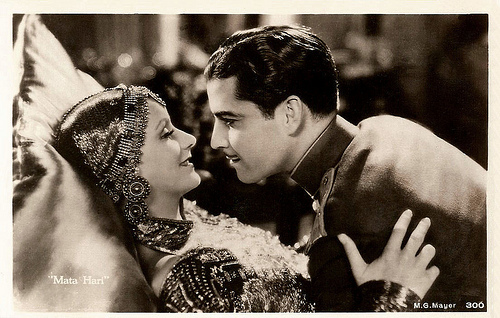
Vintage postcard, no. 300. Photo: M.G.Mayer. Publicity still for Mata Hari (George Fitzmaurice, 1931) with Ramon Novarro .
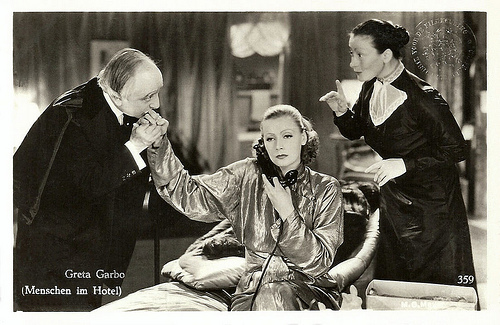
Postcard with Dutch censorship stamp, no. 359. Photo: publicity still for Grand Hotel (Edmund Goulding, 1932) with Ferdinand Gottschalk and Rafaela Ottiano.

Italian postcard by B.F.F. Edit., no. 3616. Photo: Clarence Sinclair Bull / Metro-Goldwyn-Mayer. Publicity still for Camille (George Cukor, 1936).
Garbo laughs!
In 1939, Greta Garbo made a comeback when she starred in Ninotchka (Ernst Lubitsch, 1939). Her first comedy was one of the first Hollywood films which, under the cover of a satirical, light romance, depicted the Soviet Union under Joseph Stalin as being rigid and gray when compared to its prewar years. Ninotchka was publicised with the catchphrase "Garbo laughs!", commenting on the departure of Garbo's serious and melancholy image as she transferred to comedy. Bosley Crowther, the famous New York Times film critic wrote that Garbo Garbo "demonstrated that she had the wit and flexibility to be a fine comedienne".
All of Garbo's films were in black and white which enhanced her mystery and romantic allure. Her last film was the domestic comedy Two-Faced Woman (George Cukor, 1941), which was considered a distinct step downward for her. The film drew controversy and was condemned by the Catholic Church and other groups and was a box office failure. She was 35, and had acted in twenty-eight films.
After the war, Greta Garbo hoped to return to films. She was asked to appear in Alfred Hitchcock's The Paradine Case (1947), but she turned the role down. In 1949, after making some screentests for a film project called The Wicked Dutchess which was never realised due to financial problems, Garbo retired definitively. Greta Garbo abandoned Hollywood and moved to New York City. She would jet-set with such personalities as Aristotle Onassis and Cecil Beaton, and spend the rest of her time gardening flowers and vegetables.
In the 1970s, Garbo traveled less and grew more and more eccentric, although she still took daily walks through Central Park with close friends. In the late 1980s failing health decreased her mobility. In her final year it was her family that cared for her, including taking her to dialysis treatments.
In 1990, Greta Garbo died of natural causes in New York. She was 84. In 1954, she was given a special Oscar 'for her unforgettable performances', and in 1999, the American Film Institute ranked Garbo fifth on their list of the greatest female stars of classic Hollywood cinema, after Katharine Hepburn, Bette Davis, Audrey Hepburn , and Ingrid Bergman .
Hal Erickson at AllMovie : "Even after her death in 1990, the legend of Greta Garbo was undiminished. Few of her fans talk of her in human terms; to her devotees, Greta Garbo was not so much film legend as film goddess."
Greta Garbo in a scene from Gösta Berlings Saga (1924). Source: KinoInternational (YouTube).
Greta Garbo in a scene from Die Freudlose Gasse (1925). Source: Cinema History (YouTube).
The whiskey scene in the German version of Anna Christie (1930). Source: Al Paterson (YouTube).
Sources: Hal Erickson (AllMovie), (IMDb), Wikipedia, and .

British postcard in the Picturegoer Series, London, no. 283e.

British postcard in the Picturegoer Series, London, no. 283b.

British postcard in the Picturegoer Series, London, no. 637b. Photo: Clarence Sinclair Bull / Metro-Goldwyn-Mayer. Publicity still for Anna Karenina (Clarence Brown, 1935).
Department Store Clerk
Greta Garbo was born as Greta Lovisa Gustafsson in Stockholm in 1905. Her parents were Anna Lovisa (Johansdotter), who worked at a jam factory, and Karl Alfred Gustafsson, a labourer. She had an older sister and brother, Alva and Sven. They grew up in a rundown Stockholm district.
Few who knew Greta in her formative years would have predicted the illustrious career that awaited her. In school, she did little to distinguish herself; nor was her first job, as a barbershop lather girl, indicative of future greatness.
Her father died when she was 14, leaving the family destitute. Greta was forced to leave school and to work as a clerk in the PUB department store, where she also would model for newspaper ads.
She photographed beautifully. Her first film aspirations came when she appeared in two short film advertisements, Herr och fru Stockholm/Mr. and Mrs. Stockholm (Ragnar Ring, 1920) and Konsum Stockholm Promo/How Not to Dress (Ragnar Ring, 1921), both were financed by PUB.
Greta also appeared in a one reel film for a local bakery. The films were seen by director Erik Arthur Petschler who gave her a small part as a bathing beauty in his comedy Luffar-Petter/Peter the Tramp (Erik A. Petschler, 1922).

British postcard in the Colourgraph Series, London, no. C 81. Photo: publicity still for Anna Christie (Clarence Brown, 1930).

British postcard in the Valentine's Postcard series, no. 5904 F. Photo: MGM. Publicity still for Queen Christina (Rouben Mamoulian, 1933).

French postcard by Ed. Chantal, no. 66. Photo: M.G.M. Publicity still for Conquest (Clarence Brown, 1937).
Minor Star
Greta Gustafson garnered a couple of good trade reviews. It made her confident enough to seek out and win a scholarship to Dramaten, the prestigious Royal Dramatic Theatre in Stockholm. While studying acting there, she appeared in the historical film En lyckoriddare/A Happy Knight (John W. Brunius, 1921) which features Gösta Ekman as the dashing rogue who steals the heart of the ethereal Mary Johnson. Greta played a maid.
Then she met Mauritz Stiller, one of Sweden's foremost film directors in the early 1920s. Stiller trained the 18-years old in cinema acting technique and gave her the stage name Greta Garbo. He cast her in a major role opposite Lars Hanson in Gösta Berlings Saga/The Legend of Gosta Berling (Mauritz Stiller, 1924). The epic drama was based on a novel by Nobel Prize winner Selma Lagerlöf.
Gösta Berlings Sagawas internationally successful and made Greta a minor star. On the strength of this role, she was cast in the German prostitution and depression melodrama Die Freudlose Gasse/The Joyless Street (G.W. Pabst, 1925), in which she co-starred with the Danish screen legend Asta Nielsen .
And then Hollywood called. Louis B. Mayer invited Stiller to work for MGM when Gösta Berlings Saga caught his attention. On viewing the film, Mayer admired Stiller's direction, but was not impressed with Garbo's acting and screen presence.
Mauritz Stiller insisted on bringing his protégé to Hollywood, thus, Mayer contracted her as well. Later, Garbo’s relationship with Stiller came to an end as her fame in Hollywood grew and he struggled in the studio system. In 1928 Stiller was abruptly fired from directing Garbo's second MGM film, The Temptress (1926), after repeated arguments with studio execs. Stiller returned to Sweden, where he died soon after. He was only 45 and reportedly, Garbo was devastated.

French postcard by Edition Ross, no. 5597/1, 1930-1931. Photo: Metro-Goldwyn-Mayer. Publicity still for Anna Christie (Clarence Brown, 1930).

Dutch postcard by JosPe, Arnhem, no. 34. Photo: Clarence Sinclair Bull / Metro Goldwyn Mayer. Publicity still for Anna Christie (Clarence Brown, 1930).

Dutch Postcard, no. 41. Photo: Clarence Sinclair Bull / Metro Goldwyn Mayer. Publicity still for Anna Christie (Clarence Brown, 1930).
Garbo Talks!
In Hollywood, Greta Garbo spent most of 1925 posing for nonsensical publicity photos which endeavored to create a 'mystery woman image for her. Hal Erickson at AllMovie : " but it was only after shooting commenced on Garbo's first American film, The Torrent (1926), that MGM realized it had a potential gold mine on its hands." Director of The Torrent was Monta Bell and Greta played a peasant girl turned singer opposite Ricardo Cortez. The film was a hit and despite its cool reception by the trade press, Garbo's performance was critically acclaimed.
Her third film for MGM, Flesh and the Devil (Clarence Brown, 1926), made her an international star. Her co-star was John Gilbert, and their on-screen chemistry soon translated into an off-camera romance and by the end of the production, they lived together. The Garbo/Gilbert team went on to make an adaptation of Tolstoy's Anna Karenina titled Love (Edmund Goulding, 1927). The couple planned to marry, but Garbo, in one of her attacks of self-imposed solitude, did not show up for the wedding. Over the years, the actress would have other romantic involvements, but would never marry.
Anna Christie (Clarence Brown, 1930) was filmed at a time of transition in Hollywood from the silent era to sound. Reportedly MGM had concerns about Garbo's voice. The studio was afraid that her thick Swedish accent would not register well in the talkies. Poster for her first sound film read "Garbo Talks!", which would become a catchphrase widely associated with her.
Sixteen minutes into Anna Christie, Garbo finally utters her first, now famous line, "Gimme a whiskey, ginger ale on the side, and don't be stingy, baby." Garbo's voice meshed perfectly with her established image, and her performance in Anna Christie was effective. So, when 'Garbo talks' the audience still listened.
Anna Christie, based on a play by Eugene O'Neill, became a transitional film for Garbo. Hal Erickson: "the advent of talkies obliged the actress to drop the 'mysterious temptress' characterization she'd used in silents in favor of more richly textured performances as worldly, somewhat melancholy women to whom the normal pleasures of love and contentment would always be just out of reach."
Greta Garbo had a huge following in Europe, especially in Germany. Therefor MGM also made a German version of Anna Christie. Both versions were filmed back to back. Garbo played the leading role in both versions, but all the other characters in the German version were played by different actors from the English version. Curiously, Garbo herself supposedly favoured her Anna Christie in the German version over the English version. The German version was directed by Jacques Feyder and had its first screening in Germany in 1931.

Dutch postcard. Sent by mail in 1931. Photo: Metro-Goldwyn-Mayer.

Dutch postcard by JosPe, no. 295. Photo: Metro-Goldwyn-Mayer (MGM) / Clarence Sinclair Bull. Publicity still for Mata Hari (George Fitzmaurice, 1931) .

French postcard by Edition Ross, no. 500. Photo: Clarence Sinclair Bull. Publicity still for the German version of Anna Christie (Jacques Feyder, 1930).
From the Greatest Money-making Machine to Box Office Poison
Greta Garbo next made Romance (Clarence Brown, 1930) in the same year as Anna Christie. Romance is a film with nearly no plot twists, but Garbo is stunning. She originally wanted Gary Cooper as her leading man, but MGM could not borrow Cooper from Paramount, so Garbo had to settle for Lewis Stone and the unknown Gavin Gordon. After Anna Christie, Romance (1930) was somewhat of a letdown, but for her performances in these films she received the first of three Academy Award nominations for Best Actress. Academy rules at the time allowed for a performer to receive a single nomination for their work in more than one film.
In 1931, Garbo bounced back, landing another lead role opposite Ramon Novarro as the World War I spy in Mata Hari (George Fitzmaurice, 1931). The lavish production turned out to be a major hit. The next year she was cast in yet another hit, Grand Hotel (Edmund Goulding, 1932). She played a Russian ballerina opposite an ensemble cast, including John Barrymore, Joan Crawford, and Wallace Beery. The film won an Academy Award for Best Picture. Both Mata Hari and Grand Hotel had been MGM's highest-earning films of 1931 and 1932, respectively, and Garbo was dubbed "the greatest money-making machine ever put on screen".
From now on, her popularity allowed her to dictate the terms of her contract and Garbo became increasingly selective about her roles. Queen Christina (Rouben Mamoulian, 1933) was a lavish production, becoming one of the studio's biggest productions at the time. Publicised as "Garbo returns", the film became the highest-grossing film of the year. However censors objected to the scenes in which Garbo disguised herself as a man and kissed a female co-star.
In the Leo Tolstoy adaptation Anna Karenina (Clarence Brown, 1935), she played another of her renowned roles. The film won the Mussolini Cup for best foreign film at the Venice Film Festival, and Garbo received a New York Film Critics Circle Award for Best Actress for her role as Anna. Many critics and film historians consider her performance as the doomed courtesan Marguerite Gautier in George Cukor's romantic drama Camille (1936) to be her finest. The role gained her a second Academy Award nomination.
However, Greta Garbo's career soon declined after the flop of Conquest (Clarence Brown, 1937), and in 1938, she was one of the many stars labeled "Box Office Poison".

Vintage postcard, no. 300. Photo: M.G.Mayer. Publicity still for Mata Hari (George Fitzmaurice, 1931) with Ramon Novarro .

Postcard with Dutch censorship stamp, no. 359. Photo: publicity still for Grand Hotel (Edmund Goulding, 1932) with Ferdinand Gottschalk and Rafaela Ottiano.

Italian postcard by B.F.F. Edit., no. 3616. Photo: Clarence Sinclair Bull / Metro-Goldwyn-Mayer. Publicity still for Camille (George Cukor, 1936).
Garbo laughs!
In 1939, Greta Garbo made a comeback when she starred in Ninotchka (Ernst Lubitsch, 1939). Her first comedy was one of the first Hollywood films which, under the cover of a satirical, light romance, depicted the Soviet Union under Joseph Stalin as being rigid and gray when compared to its prewar years. Ninotchka was publicised with the catchphrase "Garbo laughs!", commenting on the departure of Garbo's serious and melancholy image as she transferred to comedy. Bosley Crowther, the famous New York Times film critic wrote that Garbo Garbo "demonstrated that she had the wit and flexibility to be a fine comedienne".
All of Garbo's films were in black and white which enhanced her mystery and romantic allure. Her last film was the domestic comedy Two-Faced Woman (George Cukor, 1941), which was considered a distinct step downward for her. The film drew controversy and was condemned by the Catholic Church and other groups and was a box office failure. She was 35, and had acted in twenty-eight films.
After the war, Greta Garbo hoped to return to films. She was asked to appear in Alfred Hitchcock's The Paradine Case (1947), but she turned the role down. In 1949, after making some screentests for a film project called The Wicked Dutchess which was never realised due to financial problems, Garbo retired definitively. Greta Garbo abandoned Hollywood and moved to New York City. She would jet-set with such personalities as Aristotle Onassis and Cecil Beaton, and spend the rest of her time gardening flowers and vegetables.
In the 1970s, Garbo traveled less and grew more and more eccentric, although she still took daily walks through Central Park with close friends. In the late 1980s failing health decreased her mobility. In her final year it was her family that cared for her, including taking her to dialysis treatments.
In 1990, Greta Garbo died of natural causes in New York. She was 84. In 1954, she was given a special Oscar 'for her unforgettable performances', and in 1999, the American Film Institute ranked Garbo fifth on their list of the greatest female stars of classic Hollywood cinema, after Katharine Hepburn, Bette Davis, Audrey Hepburn , and Ingrid Bergman .
Hal Erickson at AllMovie : "Even after her death in 1990, the legend of Greta Garbo was undiminished. Few of her fans talk of her in human terms; to her devotees, Greta Garbo was not so much film legend as film goddess."
Greta Garbo in a scene from Gösta Berlings Saga (1924). Source: KinoInternational (YouTube).
Greta Garbo in a scene from Die Freudlose Gasse (1925). Source: Cinema History (YouTube).
The whiskey scene in the German version of Anna Christie (1930). Source: Al Paterson (YouTube).
Sources: Hal Erickson (AllMovie), (IMDb), Wikipedia, and .
Published on April 07, 2018 22:00
April 6, 2018
Patrick Stewart
The career of English actor Patrick Stewart (1940) has included roles on stage, television, and film in a career spanning almost six decades. The unknown Shakespearean actor suddenly became famous as Captain Jean-Luc Picard in the American TV series Star Trek: The Next Generation (1987-1994) and its successor films. Another well-known role was Professor Charles Xavier in the X-Men series of superhero movies.
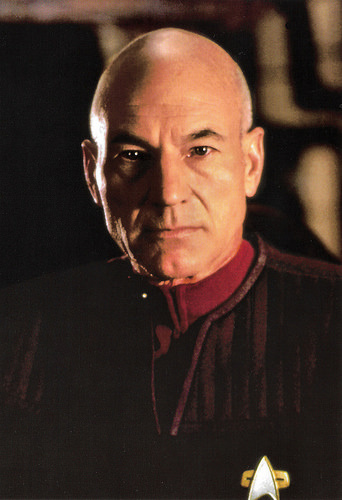
American postcard by Classico San Francisco, no. 105-485. Photo: Paramount Pictures. Patrick Stewart as Captain Jean-Luc Picard in the TV series Star Trek: The Next Generation (1991).
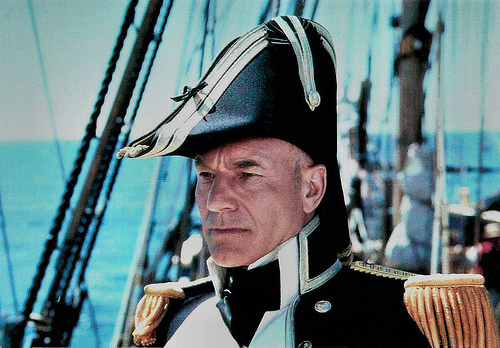
American postcard by Classico San Francisco, no. 105-352. Photo: Paramount Pictures. Patrick Stewart as Captain Jean-Luc Picard in Star Trek Generations (David Carson, 1994).
A traumatic experience
Patrick Stewart was born in 1940 in Mirfield, in Yorkshire, England. His parents were Gladys (née Barrowclough), a weaver and textile worker, and Alfred Stewart, a regimental sergeant major in the British Army. He has two older brothers, Geoffrey and Trevor.
Stewart grew up in a poor household with domestic violence from his father who suffered a post-traumatic stress disorder. This experience later influenced Stewart's political and ideological beliefs. Stewart attended Crowlees Church of England Junior and Infants School, where his English teacher stimulated him to perform. In 1951, aged 11, having failed the eleven-plus examination, he entered Mirfield Secondary Modern School, where he continued to study drama.
At the age of 15, Stewart left school to work as a junior reporter on a local paper; he quit when his editor told him he was spending too much time at the theatre. At the age of 18, he lost his hair, a traumatic experience which made him more timid. For him, acting served as a means of self-expression. Stewart spent a year as a furniture salesman, saving cash to attend drama school. In 1957, Stewart received a grant to attend the Bristol Old Vic Theatre School.
In 1959, he made his stage debut. Following a period with Manchester's Library Theatre, he became a member of the Royal Shakespeare Company in 1966. Stewart received the 1979 Laurence Olivier Award for Best Actor in a Supporting Role for his performance in Antony and Cleopatra on the West End. He made his Broadway debut as Snout in Peter Brook's legendary production of A Midsummer Night's Dream. He remained with the Royal Shakespeare Company until 1982.
In the early 1980s, he moved to the Royal National Theatre. In 1967, he had made his television debut in Coronation Street as a fire officer. Over the years, Stewart took roles in many major TV series without ever becoming a household name. He appeared as Vladimir Lenin in Fall of Eagles (1974); Sejanus in I, Claudius (Herbert Wise, 1976); Karla in Tinker Tailor Soldier Spy (John Irvin, 1979) and Smiley's People (Simon Langton, 1982); and Claudius in a BBC adaptation of Hamlet (Rodney Bennett, 1980) with Derek Jacobi and Claire Bloom .
He even took the romantic male lead in the BBC adaptation of Elizabeth Gaskell's North and South (Rodney Bennett, 1975) wearing a hairpiece. He also co-starred with Peter Eyre and Glenda Jackson in Hedda (Trevor Nunn, 1975), a film adaptation of Henrik Ibsen's Hedda Gabler. He took the lead, playing psychiatric consultant Dr Edward Roebuck in BBC's Maybury (1981). Stewart played minor roles in such films as Excalibur (John Boorman, 1981), Dune (David Lynch, 1984) and British science fiction horror film Lifeforce (Tobe Hooper, 1985).
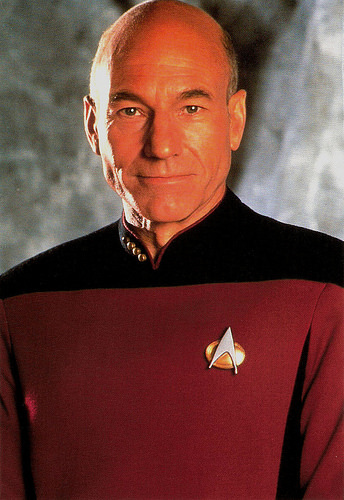
American postcard by Classico San Francisco, no. 105-148. Photo: Paramount Pictures. Patrick Stewart as Captain Jean-Luc Picard in the TV series Star Trek: The Next Generation (1991).
Unexpected stardom and wealth
In 1987, Patrick Stewart agreed to work in Hollywood on a revival of an old science-fiction television show. Reportedly, Stewart knew nothing about the original show, Star Trek, or its iconic status in American culture. He was reluctant to sign the standard contract of six years but accepted the role of Captain Jean-Luc Picard in Star Trek: The Next Generation (1987–1994).
Stewart unexpectedly became a star and wealthy. From 1994 to 2002, he also portrayed Picard in the films Star Trek Generations (David Carson, 1994), Star Trek: First Contact (Jonathan Frakes, 1996), Star Trek: Insurrection (Jonathan Frakes, 1998) and Star Trek: Nemesis (Stuart Baird, 2002); and in Star Trek: Deep Space Nine's pilot episode Emissary (David Carson, 1993). This success typecast Stewart as Picard and obtaining other roles became difficult. He also found returning to the stage difficult because of his long departure.
In the late 1990s he accepted a key role in the big-budget X-Men film series, as Professor Charles Xavier, founder and mentor of the superhero team, a role similar in many ways to Picard. He was initially reluctant to sign on to another movie franchise, but his interest in working with director Bryan Singer persuaded him. Stewart played the role in seven feature films: X-Men (Bryan Singer, 2000), X2 (Bryan Singer, 2003), X-Men: The Last Stand (Brett Ratner, 2006), X-Men Origins: Wolverine (Gavin Hood, 2009) starring Hugh Jackman, The Wolverine (James Mangold, 2013), X-Men: Days of Future Past (Bryan Singer, 2014) and Logan (James Mangold, 2017) and voiced the role in several video.
Stewart's other film and television roles include the flamboyantly gay Sterling in Jeffrey (Christopher Ashley, 1995) and King Henry II in The Lion in Winter (Andrey Konchalovskiy, 2003), for which he received a Golden Globe Award nomination for his performance and an Emmy Award nomination for executive-producing the film.
Stewart portrayed Captain Ahab in the TV film Moby Dick (Franc Roddam, 1998), receiving an Emmy Award nomination and Golden Globe Award nomination for his performance. He also starred as Ebenezer Scrooge in a television film version of Charles Dickens' A Christmas Carol (David Jones, 1999), for which he received a Screen Actors Guild Award nomination.
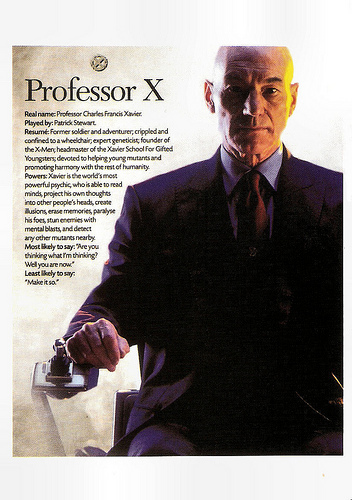
American postcard by Memory Card, no. 668,. Photo: Patrick Stewart as Professor X in X-Men (Bryan Singer, 2000).
Domestic violence
In late 2003, during the final season of the TV series Frasier, Patrick Stewart appeared on the show as a gay Seattle socialite and opera director, who mistakes Frasier for a potential lover. In 2005, he was cast as Professor Ian Hood in an ITV thriller 4-episode series Eleventh Hour (2006), created by Stephen Gallagher.
He played Captain Nemo in a two-part adaptation of The Mysterious Island (Russell Mulcahy, 2005) opposite Kyle MacLachlan. Stewart also appeared as a nudity-obsessed caricature of himself in Ricky Gervais and Stephen Merchant's television series Extras (2005).
In 2006, Stewart made a short video against domestic violence for Amnesty International, in which he recollected his father's physical attacks on his mother and the effect it had on him as a child. He did voice roles such as CIA Deputy Director Avery Bullock in the animation series American Dad! (2005-2017) and was the narrator in Ted (Seth MacFarlane, 2012).
Stewart remained performing with the Royal Shakespeare Company. In 2008 he played King Claudius in Hamlet on the West End and won a second Olivier Award. He was awarded the OBE (Officer of the Order of the British Empire) in the 2000 Queen's Millennium Honours list for his services to acting and the cinema. In 2010, Stewart was knighted by Queen Elizabeth II for services to drama.
Stewart and his first wife, Sheila Falconer, divorced in 1990 after 24 years of marriage. They have two children, son Daniel and daughter Sophia. Daniel is a television actor, and has appeared alongside his father in the made-for-television film Death Train (David Jackson, 1993) starring Pierce Brosnan , and the Star Trek: The Next Generation episode The Inner Light (1992).
In 1997, Stewart became engaged to Wendy Neuss, one of the producers of Star Trek: The Next Generation. They married in August 2000, and divorced three years later. Four months before his divorce from Neuss, Stewart played opposite actress Lisa Dillon in a production of The Master Builder, and the two were romantically involved until 2007.
In 2008, Patrick Stewart began dating Sunny Ozell, a singer and songwriter based in New York, whom Stewart met while performing in Macbeth at the Brooklyn Academy of Music. They married in 2013 with Sir Ian McKellen performing the wedding ceremony.
Recently Patrick Stewart played an ageing Juilliard dance professor with a colourful past in the film Match (Stephen Belber, 2015) with Carla Gugino and Matthew Lillard, and stars as Walter Blunt, a British journalist, intent on conquering American nightly cable news and his mostly misguided decision-making in the TV series Blunt Talk (2015-2016).
Trailer for Match (2015). Source: Movieclips Film Festivals & Indie Films (YouTube).
Trailer for the second series of Blunt Talk (2016). Source: JoBlo TV Show Trailers (YouTube).
Sources: Wikipedia and .

American postcard by Classico San Francisco, no. 105-485. Photo: Paramount Pictures. Patrick Stewart as Captain Jean-Luc Picard in the TV series Star Trek: The Next Generation (1991).

American postcard by Classico San Francisco, no. 105-352. Photo: Paramount Pictures. Patrick Stewart as Captain Jean-Luc Picard in Star Trek Generations (David Carson, 1994).
A traumatic experience
Patrick Stewart was born in 1940 in Mirfield, in Yorkshire, England. His parents were Gladys (née Barrowclough), a weaver and textile worker, and Alfred Stewart, a regimental sergeant major in the British Army. He has two older brothers, Geoffrey and Trevor.
Stewart grew up in a poor household with domestic violence from his father who suffered a post-traumatic stress disorder. This experience later influenced Stewart's political and ideological beliefs. Stewart attended Crowlees Church of England Junior and Infants School, where his English teacher stimulated him to perform. In 1951, aged 11, having failed the eleven-plus examination, he entered Mirfield Secondary Modern School, where he continued to study drama.
At the age of 15, Stewart left school to work as a junior reporter on a local paper; he quit when his editor told him he was spending too much time at the theatre. At the age of 18, he lost his hair, a traumatic experience which made him more timid. For him, acting served as a means of self-expression. Stewart spent a year as a furniture salesman, saving cash to attend drama school. In 1957, Stewart received a grant to attend the Bristol Old Vic Theatre School.
In 1959, he made his stage debut. Following a period with Manchester's Library Theatre, he became a member of the Royal Shakespeare Company in 1966. Stewart received the 1979 Laurence Olivier Award for Best Actor in a Supporting Role for his performance in Antony and Cleopatra on the West End. He made his Broadway debut as Snout in Peter Brook's legendary production of A Midsummer Night's Dream. He remained with the Royal Shakespeare Company until 1982.
In the early 1980s, he moved to the Royal National Theatre. In 1967, he had made his television debut in Coronation Street as a fire officer. Over the years, Stewart took roles in many major TV series without ever becoming a household name. He appeared as Vladimir Lenin in Fall of Eagles (1974); Sejanus in I, Claudius (Herbert Wise, 1976); Karla in Tinker Tailor Soldier Spy (John Irvin, 1979) and Smiley's People (Simon Langton, 1982); and Claudius in a BBC adaptation of Hamlet (Rodney Bennett, 1980) with Derek Jacobi and Claire Bloom .
He even took the romantic male lead in the BBC adaptation of Elizabeth Gaskell's North and South (Rodney Bennett, 1975) wearing a hairpiece. He also co-starred with Peter Eyre and Glenda Jackson in Hedda (Trevor Nunn, 1975), a film adaptation of Henrik Ibsen's Hedda Gabler. He took the lead, playing psychiatric consultant Dr Edward Roebuck in BBC's Maybury (1981). Stewart played minor roles in such films as Excalibur (John Boorman, 1981), Dune (David Lynch, 1984) and British science fiction horror film Lifeforce (Tobe Hooper, 1985).

American postcard by Classico San Francisco, no. 105-148. Photo: Paramount Pictures. Patrick Stewart as Captain Jean-Luc Picard in the TV series Star Trek: The Next Generation (1991).
Unexpected stardom and wealth
In 1987, Patrick Stewart agreed to work in Hollywood on a revival of an old science-fiction television show. Reportedly, Stewart knew nothing about the original show, Star Trek, or its iconic status in American culture. He was reluctant to sign the standard contract of six years but accepted the role of Captain Jean-Luc Picard in Star Trek: The Next Generation (1987–1994).
Stewart unexpectedly became a star and wealthy. From 1994 to 2002, he also portrayed Picard in the films Star Trek Generations (David Carson, 1994), Star Trek: First Contact (Jonathan Frakes, 1996), Star Trek: Insurrection (Jonathan Frakes, 1998) and Star Trek: Nemesis (Stuart Baird, 2002); and in Star Trek: Deep Space Nine's pilot episode Emissary (David Carson, 1993). This success typecast Stewart as Picard and obtaining other roles became difficult. He also found returning to the stage difficult because of his long departure.
In the late 1990s he accepted a key role in the big-budget X-Men film series, as Professor Charles Xavier, founder and mentor of the superhero team, a role similar in many ways to Picard. He was initially reluctant to sign on to another movie franchise, but his interest in working with director Bryan Singer persuaded him. Stewart played the role in seven feature films: X-Men (Bryan Singer, 2000), X2 (Bryan Singer, 2003), X-Men: The Last Stand (Brett Ratner, 2006), X-Men Origins: Wolverine (Gavin Hood, 2009) starring Hugh Jackman, The Wolverine (James Mangold, 2013), X-Men: Days of Future Past (Bryan Singer, 2014) and Logan (James Mangold, 2017) and voiced the role in several video.
Stewart's other film and television roles include the flamboyantly gay Sterling in Jeffrey (Christopher Ashley, 1995) and King Henry II in The Lion in Winter (Andrey Konchalovskiy, 2003), for which he received a Golden Globe Award nomination for his performance and an Emmy Award nomination for executive-producing the film.
Stewart portrayed Captain Ahab in the TV film Moby Dick (Franc Roddam, 1998), receiving an Emmy Award nomination and Golden Globe Award nomination for his performance. He also starred as Ebenezer Scrooge in a television film version of Charles Dickens' A Christmas Carol (David Jones, 1999), for which he received a Screen Actors Guild Award nomination.

American postcard by Memory Card, no. 668,. Photo: Patrick Stewart as Professor X in X-Men (Bryan Singer, 2000).
Domestic violence
In late 2003, during the final season of the TV series Frasier, Patrick Stewart appeared on the show as a gay Seattle socialite and opera director, who mistakes Frasier for a potential lover. In 2005, he was cast as Professor Ian Hood in an ITV thriller 4-episode series Eleventh Hour (2006), created by Stephen Gallagher.
He played Captain Nemo in a two-part adaptation of The Mysterious Island (Russell Mulcahy, 2005) opposite Kyle MacLachlan. Stewart also appeared as a nudity-obsessed caricature of himself in Ricky Gervais and Stephen Merchant's television series Extras (2005).
In 2006, Stewart made a short video against domestic violence for Amnesty International, in which he recollected his father's physical attacks on his mother and the effect it had on him as a child. He did voice roles such as CIA Deputy Director Avery Bullock in the animation series American Dad! (2005-2017) and was the narrator in Ted (Seth MacFarlane, 2012).
Stewart remained performing with the Royal Shakespeare Company. In 2008 he played King Claudius in Hamlet on the West End and won a second Olivier Award. He was awarded the OBE (Officer of the Order of the British Empire) in the 2000 Queen's Millennium Honours list for his services to acting and the cinema. In 2010, Stewart was knighted by Queen Elizabeth II for services to drama.
Stewart and his first wife, Sheila Falconer, divorced in 1990 after 24 years of marriage. They have two children, son Daniel and daughter Sophia. Daniel is a television actor, and has appeared alongside his father in the made-for-television film Death Train (David Jackson, 1993) starring Pierce Brosnan , and the Star Trek: The Next Generation episode The Inner Light (1992).
In 1997, Stewart became engaged to Wendy Neuss, one of the producers of Star Trek: The Next Generation. They married in August 2000, and divorced three years later. Four months before his divorce from Neuss, Stewart played opposite actress Lisa Dillon in a production of The Master Builder, and the two were romantically involved until 2007.
In 2008, Patrick Stewart began dating Sunny Ozell, a singer and songwriter based in New York, whom Stewart met while performing in Macbeth at the Brooklyn Academy of Music. They married in 2013 with Sir Ian McKellen performing the wedding ceremony.
Recently Patrick Stewart played an ageing Juilliard dance professor with a colourful past in the film Match (Stephen Belber, 2015) with Carla Gugino and Matthew Lillard, and stars as Walter Blunt, a British journalist, intent on conquering American nightly cable news and his mostly misguided decision-making in the TV series Blunt Talk (2015-2016).
Trailer for Match (2015). Source: Movieclips Film Festivals & Indie Films (YouTube).
Trailer for the second series of Blunt Talk (2016). Source: JoBlo TV Show Trailers (YouTube).
Sources: Wikipedia and .
Published on April 06, 2018 22:00
April 5, 2018
ASER
Italian films made during the fascist period were usually not 'fascist' in tone, although they were often nationalistic and patriotic, much like their Hollywood counterparts. Vittorio De Sica was the most popular actor in fascist Italy, playing roles similar to those by Cary Grant and James Stewart. His comedy Il Signor Max/Mr. Max (Mario Camerini, 1937) established a level of craftsmanship and witty sophistication that rivals the best Hollywood products during the same period. A. Scarmiglia created popular collectors cards and postcards of De Sica and other Italian stars of the late 1930s and early 1940s. Scarmiglia published them under the abbreviation ASER (A. Scaramaglia Edizioni, Roma). Here are 20 examples.
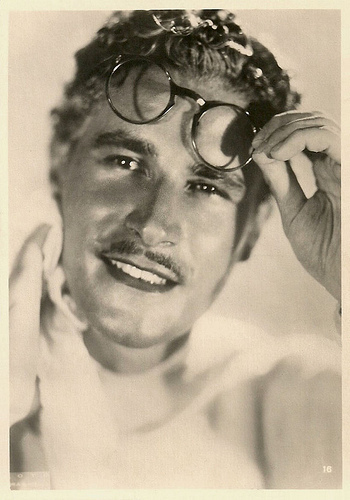
Amedeo Nazzari . Italian postcard by ASER, Rome, no. 16, 1941.
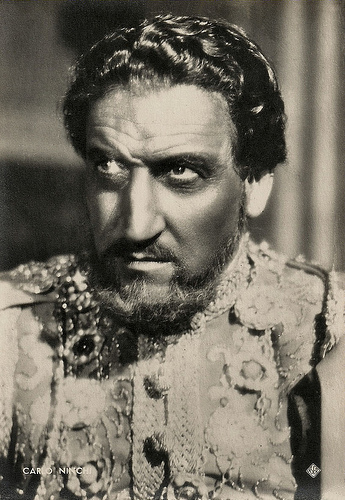
Carlo Ninchi . Italian card by ASER, Rome, no. 33. Photo: Pesce / Scalera Film.
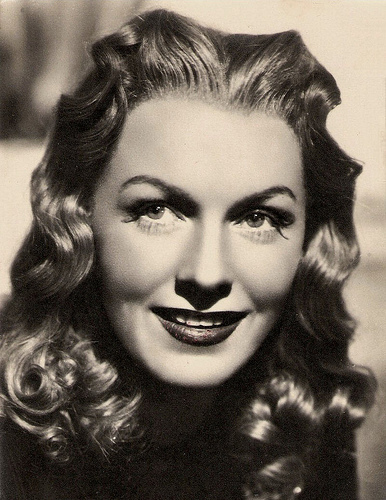
Assia Noris . Italian card by ASER, Rome, no. 43. Photo: Vaselli / Juventus.
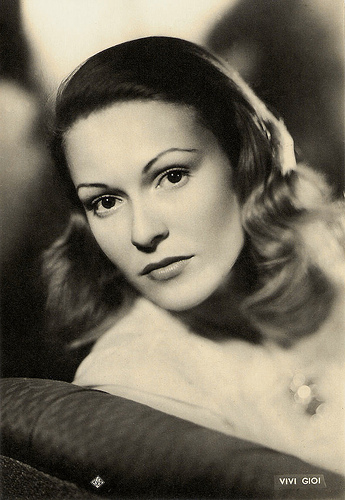
Vivi Gioi. Italian postcard. ASER, Rome, no. 54. Photo: De Antonis.
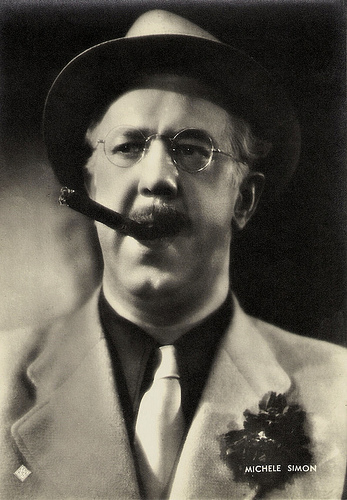
Michel Simon . Italian postcard by ASER, Rome, no. 93. Photo: Pesce.
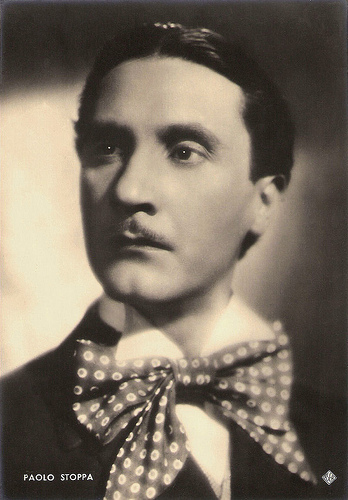
Paolo Stoppa . Italian postcard by ASER, no. 96. Photo: Pesce.
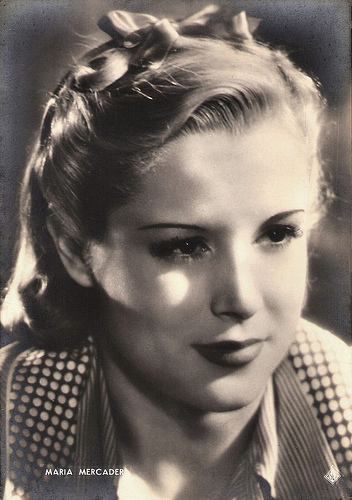
Maria Mercader . Italian card by ASER, Rome, no. 105. Photo: Bragaglia / Atlas Film.
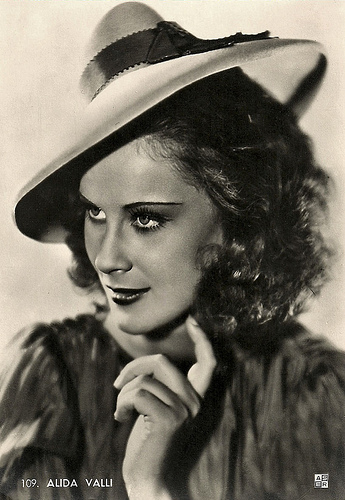
Alida Valli . Italian postcard by ASER, Rome, no. 109.
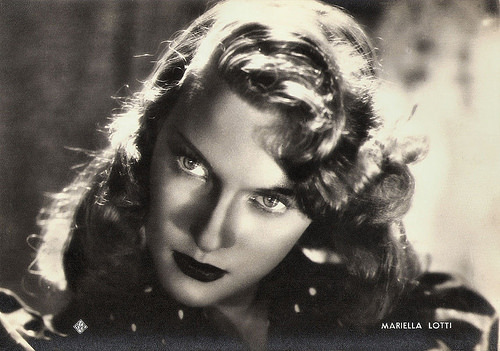
Mariella Lotti . Italian card by ASER, Romne, no. 122. Photo: Fauno Film / Vaselli. Publicity still for Fari nella nebbia/Headlights in the fog (Gianni Franciolini, 1941).
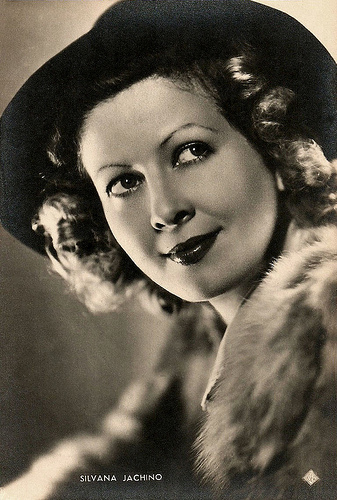
Silvana Jachino . Italian card by ASER, Rome, no. 150. Photo: Ciolfi.
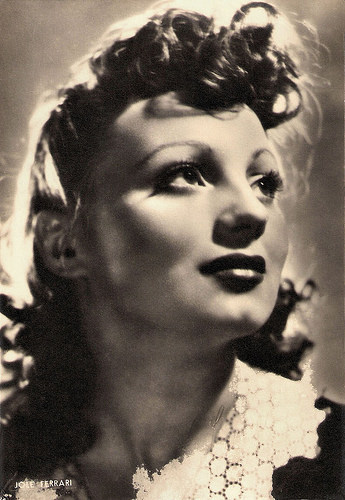
Jole Ferrari . Italian card by ASER, no. 152. Photo: Luxardo.
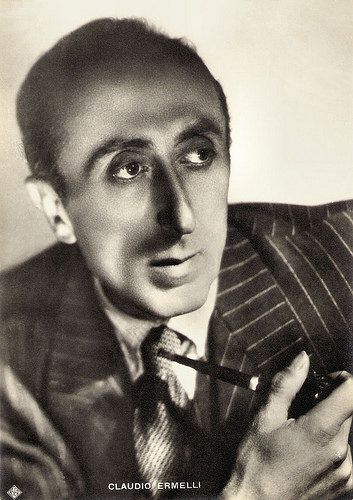
Claudio Ermelli . Italian card by ASER, Rome, no. 153. Photo: Fotopan.
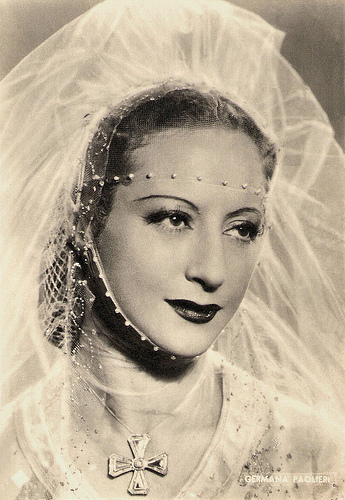
Germana Paolieri . Italian card by ASER, Rome, no. 156. Photo: publicity still for Pia De' Tolomei (Esodo Pratelli, 1941).
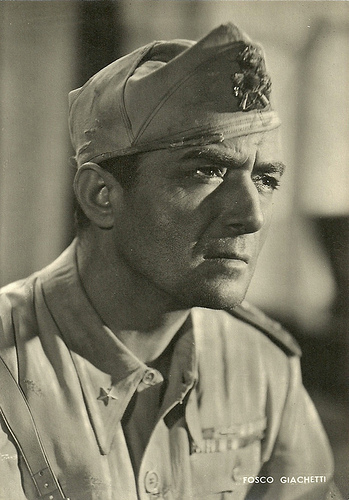
Fosco Giachetti . Italian card by ASER, Rome, no. 178. Photo: Bassoli / Tirrenia. Publicity still for Bengasi (Augusto Genina, 1942).
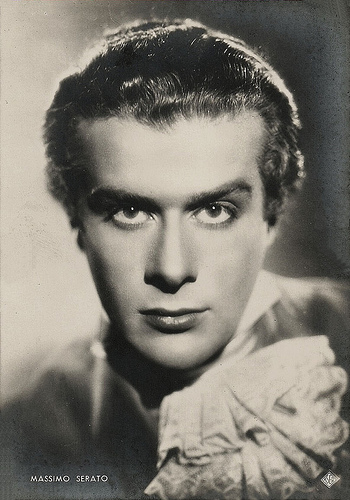
Massimo Serato . Italian card by ASER, Rome, no. 221. Photo: Ciolfi / Aci Film.
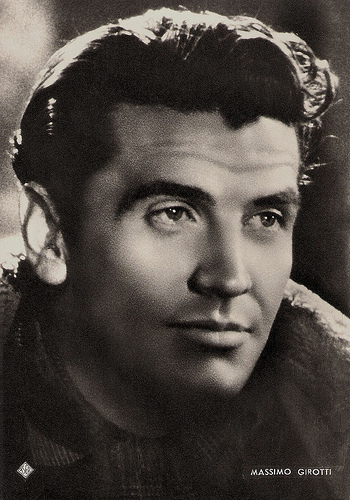
Massimo Girotti . Italian card by ASER, Rome, no. 223. Photo: Ciolfi.
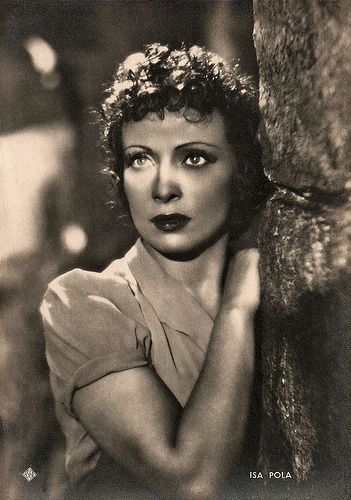
Isa Pola . Italian card by ASER, Rome, no. 240. Photo: Pesce / Scalera Film. Publicity still for Una signora dell'ovest/Girl of the Golden West (Carl Koch, 1942).
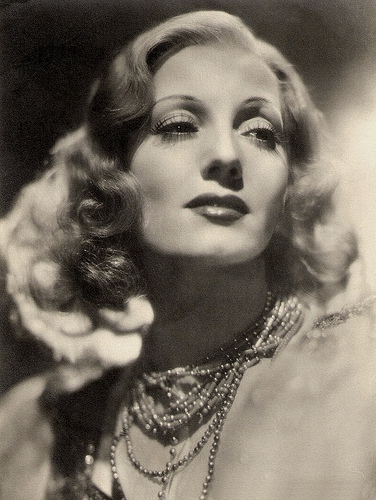
Isa Miranda . Italian card by ASER, Rome, no. 258.
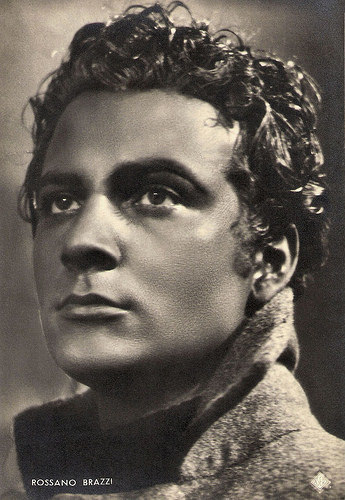
Rossano Brazzi. Italian card by ASER, Rome, no. 264.
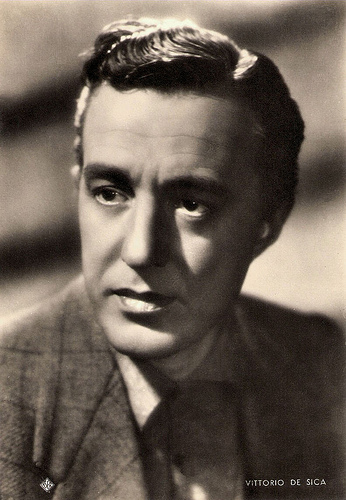
Vittorio De Sica . Italian card by ASER, Rome, no. 333. Photo: Vaselli.
Source: Film Reference.

Amedeo Nazzari . Italian postcard by ASER, Rome, no. 16, 1941.

Carlo Ninchi . Italian card by ASER, Rome, no. 33. Photo: Pesce / Scalera Film.

Assia Noris . Italian card by ASER, Rome, no. 43. Photo: Vaselli / Juventus.

Vivi Gioi. Italian postcard. ASER, Rome, no. 54. Photo: De Antonis.

Michel Simon . Italian postcard by ASER, Rome, no. 93. Photo: Pesce.

Paolo Stoppa . Italian postcard by ASER, no. 96. Photo: Pesce.

Maria Mercader . Italian card by ASER, Rome, no. 105. Photo: Bragaglia / Atlas Film.

Alida Valli . Italian postcard by ASER, Rome, no. 109.

Mariella Lotti . Italian card by ASER, Romne, no. 122. Photo: Fauno Film / Vaselli. Publicity still for Fari nella nebbia/Headlights in the fog (Gianni Franciolini, 1941).

Silvana Jachino . Italian card by ASER, Rome, no. 150. Photo: Ciolfi.

Jole Ferrari . Italian card by ASER, no. 152. Photo: Luxardo.

Claudio Ermelli . Italian card by ASER, Rome, no. 153. Photo: Fotopan.

Germana Paolieri . Italian card by ASER, Rome, no. 156. Photo: publicity still for Pia De' Tolomei (Esodo Pratelli, 1941).

Fosco Giachetti . Italian card by ASER, Rome, no. 178. Photo: Bassoli / Tirrenia. Publicity still for Bengasi (Augusto Genina, 1942).

Massimo Serato . Italian card by ASER, Rome, no. 221. Photo: Ciolfi / Aci Film.

Massimo Girotti . Italian card by ASER, Rome, no. 223. Photo: Ciolfi.

Isa Pola . Italian card by ASER, Rome, no. 240. Photo: Pesce / Scalera Film. Publicity still for Una signora dell'ovest/Girl of the Golden West (Carl Koch, 1942).

Isa Miranda . Italian card by ASER, Rome, no. 258.

Rossano Brazzi. Italian card by ASER, Rome, no. 264.

Vittorio De Sica . Italian card by ASER, Rome, no. 333. Photo: Vaselli.
Source: Film Reference.
Published on April 05, 2018 22:00
April 4, 2018
Robert Lamoureux
French actor, screenwriter and film director Robert Lamoureux (1920-2011) started as a stand-up comedian avant-la-lettre, and became a charming and funny star of the French film comedy in the 1950s. Between 1951 and 1994, he appeared in 37 films, and in the 1970s, he directed the popular farces about La Septième Compagnie (the Seventh Company).
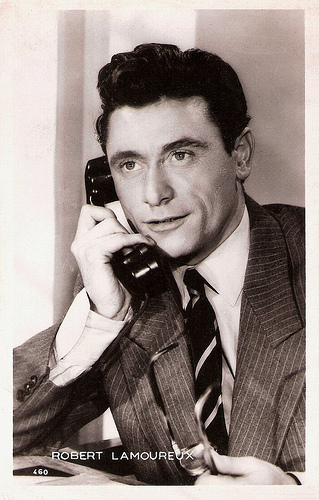
French postcard, no. 460.
Forerunner of Today’s Stand-up Comedy
Robert Lamoureux was born in 1920 in Saint-Mandé, France.
He started his career in 1948 in a cabaret called Le Central de la Chanson. Next he did a revue with Pierre Dac and Francis Blanche at the cabaret of Jacques Canetti. He performed his own songs and recited very funny monologues. He was a forerunner of today’s stand-up comedy, and his success was enormous.
As a true showman, Lamoureux subsequently worked in all divisions of the entertainment industry: the music hall, the music record business, radio, theatre, cinema and television. He was the author of several Boulevard plays (popular French stage plays) and received a Grand Prix du Disque (a major award of the French music industry) before he became interested in the cinema.
His first roles were in such films as Le roi des camelots/The king of the street vendors (André Berthomieu, 1950), Chacun son tour/Each in turn (André Berthomieu, 1951), and Allô je t'aime/Hello I love you (André Berthomieu, 1952), in which he was charming and funny.
He appeared next in the Italian film L'incantevole nemica/The charming enemy (Claudio Gora, 1953) opposite Silvana Pampanini and silent screen legends Buster Keaton and Ben Turpin.
He became immensely popular as Robert Langlois in Papa, maman, la bonne et moi/Daddy, Mommy, the Maid and I (Jean-Paul Le Chanois, 1954), which was inspired by one of his cabaret numbers. He also starred in the sequel Papa, maman, ma femme et moi/Dad, Mom, my wife and I (Jean-Paul Le Chanois, 1955).
In 1955 he appeared with Betsy Blair in Rencontre à Paris/Meeting in Paris (Georges Lampin, 1956). Twice he played famous gentleman-burglar Arsène Lupin in Les Aventures d'Arsène Lupin/The Adventures of Arsène Lupin (Jacques Becker, 1956) and in Signé Arsène Lupin/Signed Arsene Lupin (Yves Robert, 1959) with Alida Valli .
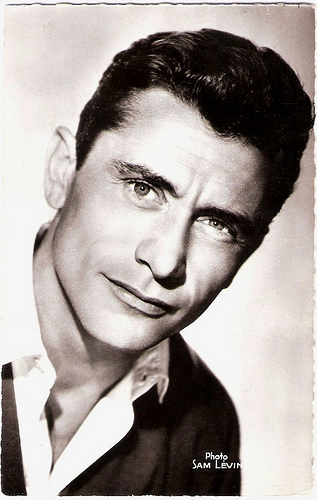
French postcard. Photo: Sam Lévin.
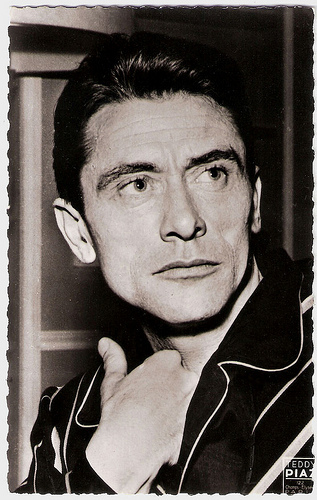
French postcard by Editions P.I., Paris, no. 821. Offered by Les carbones Korès Carboplane. Photo: Teddy Piaz.
Reinventing the Military Farce
In 1960, Robert Lamoureux went behind the camera to make film adaptations of the Boulevard plays which he had written. He directed and starred in the situation comedies Ravissante/Lovely (1960) with Sylva Koscina , and La brune que voilà/There is the Brunette (1960) with Michèle Mercier . Both were successful in the theatres but repelled the critics.
After a long hiatus in the cinema, Lamoureux reinvented the military farce, notably with the series of La Septième Compagnie, starring Jean Lefebvre , Pierre Mondy and Lamoureux himself.
The adventures of the seventh company filled the French cinemas with the films Mais où est donc passée la septième compagnie?/Now Where Did The 7th Company Get To? (1973), On a retrouvé la septième compagnie/The Seventh Company Has Been Found (1975), and La Septième Compagnie au clair de lune/The Seventh Company Outdoors (1977).
In 1972, he had a dispute with French singer Claude François. Lamoureux had written a song Viens dans ma maison (Come into my house) and Francois had written the song Viens à la maison (Come home). Lamoureux won the plagiarism case, and Francois had to change the title of his song.
Lamoureux wrote several more songs such as Papa, maman, la bonne et moi (Daddy, Mommy, the Maid and I) and Histoire de roses (History of roses) and also some poems like L'éloge de la fatigue (In Praise of Fatigue).
Lamoureux played one of his best roles in L'Apprenti salaud/The Apprentice Heel (Michel Deville, 1977), and he appeared opposite Danielle Darrieux and Micheline Presle in the comedy Le Jour des rois/Epiphany Sunday (Marie-Claude Treilhou, 1990).
However, he stated that film bored him and that he preferred the theatre. To the stage he devoted the remainder of his career. Robert Lamoureux has been married to Magali Vendeuil, resident actress of the Comédie Française, until her death in 2009.
In 2011, Robert Lamoureux passed away by natural causes in Boulogne-Billancourt, France. He had four children, three with his first wife and a daughter with Vendeuil.
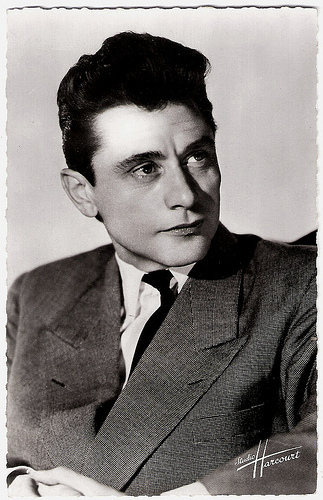
French postcard by Editions du Globe, Paris, no. 173. Photo: Studio Harcourt.
Scene from one of the La Septième Compagnie films. Source: Teddy Leleux (YouTube).
Sources: AlloCiné (French), Sandra Brennan (AllMovie), Wikipedia (French), and .

French postcard, no. 460.
Forerunner of Today’s Stand-up Comedy
Robert Lamoureux was born in 1920 in Saint-Mandé, France.
He started his career in 1948 in a cabaret called Le Central de la Chanson. Next he did a revue with Pierre Dac and Francis Blanche at the cabaret of Jacques Canetti. He performed his own songs and recited very funny monologues. He was a forerunner of today’s stand-up comedy, and his success was enormous.
As a true showman, Lamoureux subsequently worked in all divisions of the entertainment industry: the music hall, the music record business, radio, theatre, cinema and television. He was the author of several Boulevard plays (popular French stage plays) and received a Grand Prix du Disque (a major award of the French music industry) before he became interested in the cinema.
His first roles were in such films as Le roi des camelots/The king of the street vendors (André Berthomieu, 1950), Chacun son tour/Each in turn (André Berthomieu, 1951), and Allô je t'aime/Hello I love you (André Berthomieu, 1952), in which he was charming and funny.
He appeared next in the Italian film L'incantevole nemica/The charming enemy (Claudio Gora, 1953) opposite Silvana Pampanini and silent screen legends Buster Keaton and Ben Turpin.
He became immensely popular as Robert Langlois in Papa, maman, la bonne et moi/Daddy, Mommy, the Maid and I (Jean-Paul Le Chanois, 1954), which was inspired by one of his cabaret numbers. He also starred in the sequel Papa, maman, ma femme et moi/Dad, Mom, my wife and I (Jean-Paul Le Chanois, 1955).
In 1955 he appeared with Betsy Blair in Rencontre à Paris/Meeting in Paris (Georges Lampin, 1956). Twice he played famous gentleman-burglar Arsène Lupin in Les Aventures d'Arsène Lupin/The Adventures of Arsène Lupin (Jacques Becker, 1956) and in Signé Arsène Lupin/Signed Arsene Lupin (Yves Robert, 1959) with Alida Valli .

French postcard. Photo: Sam Lévin.

French postcard by Editions P.I., Paris, no. 821. Offered by Les carbones Korès Carboplane. Photo: Teddy Piaz.
Reinventing the Military Farce
In 1960, Robert Lamoureux went behind the camera to make film adaptations of the Boulevard plays which he had written. He directed and starred in the situation comedies Ravissante/Lovely (1960) with Sylva Koscina , and La brune que voilà/There is the Brunette (1960) with Michèle Mercier . Both were successful in the theatres but repelled the critics.
After a long hiatus in the cinema, Lamoureux reinvented the military farce, notably with the series of La Septième Compagnie, starring Jean Lefebvre , Pierre Mondy and Lamoureux himself.
The adventures of the seventh company filled the French cinemas with the films Mais où est donc passée la septième compagnie?/Now Where Did The 7th Company Get To? (1973), On a retrouvé la septième compagnie/The Seventh Company Has Been Found (1975), and La Septième Compagnie au clair de lune/The Seventh Company Outdoors (1977).
In 1972, he had a dispute with French singer Claude François. Lamoureux had written a song Viens dans ma maison (Come into my house) and Francois had written the song Viens à la maison (Come home). Lamoureux won the plagiarism case, and Francois had to change the title of his song.
Lamoureux wrote several more songs such as Papa, maman, la bonne et moi (Daddy, Mommy, the Maid and I) and Histoire de roses (History of roses) and also some poems like L'éloge de la fatigue (In Praise of Fatigue).
Lamoureux played one of his best roles in L'Apprenti salaud/The Apprentice Heel (Michel Deville, 1977), and he appeared opposite Danielle Darrieux and Micheline Presle in the comedy Le Jour des rois/Epiphany Sunday (Marie-Claude Treilhou, 1990).
However, he stated that film bored him and that he preferred the theatre. To the stage he devoted the remainder of his career. Robert Lamoureux has been married to Magali Vendeuil, resident actress of the Comédie Française, until her death in 2009.
In 2011, Robert Lamoureux passed away by natural causes in Boulogne-Billancourt, France. He had four children, three with his first wife and a daughter with Vendeuil.

French postcard by Editions du Globe, Paris, no. 173. Photo: Studio Harcourt.
Scene from one of the La Septième Compagnie films. Source: Teddy Leleux (YouTube).
Sources: AlloCiné (French), Sandra Brennan (AllMovie), Wikipedia (French), and .
Published on April 04, 2018 22:00
April 3, 2018
La casa di vetro (1920)
Maria Jacobiniand Amleto Novelli star in the Italian silent melodrama La casa di vetro/The glass house (Gennaro Righelli, 1920). G.B. Falci in Milan published the postcards.
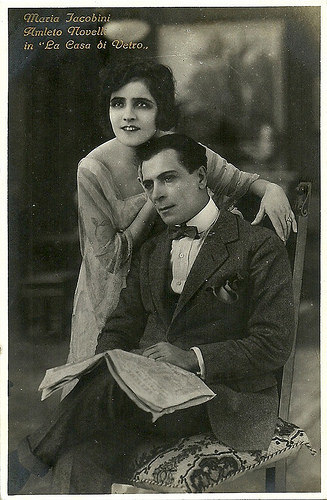
Italian postcard by G.B. Falci, Milano. Photo: publicity still for La casa di vetro/The glass house (Gennaro Righelli, 1920), starring Maria Jacobini and Amleto Novelli .
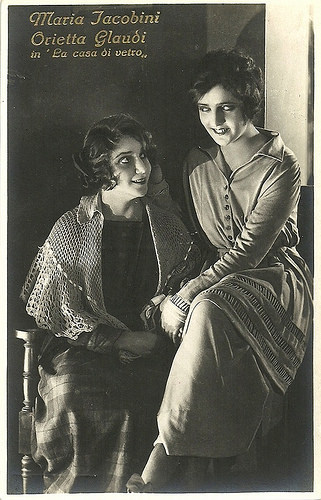
Italian postcard by G.B. Falci, Milano. Photo: publicity still for La casa di vetro/The glass house (Gennaro Righelli, 1920), with Maria Jacobini and Orietta Claudi.
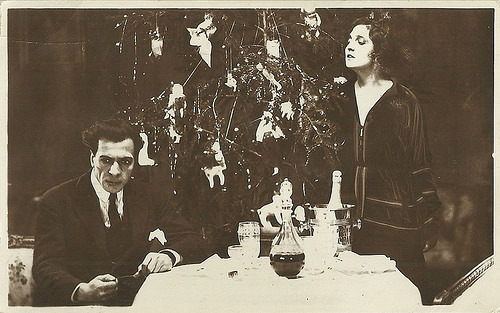
Italian postcard. Caption on the back: 'Triste Natale' (Sad Christmas). Photo: Fert. Publicity still for La casa di vetro/The glass house (Gennaro Righelli, 1920), starring Maria Jacobini and Amleto Novelli .
Breaking glass
Italian diva Maria Jacobini plays in La casa di vetro/The glass house (Gennaro Righelli 1920) the mundane city girl Gaby Printemps. During a trip, and accompanied by her good fried Max (Oreste Bilancia), Gaby is struck by the quiet life in a mountain village, and decides to remain there.
She meets Roberto Landi ( Amleto Novelli ), a simple and honest young man, and the two fall in love, creating endless suffering for Roberto's fiancee Grazia (Orietta Claudi) and his parents. They move to the city, but their different life styles soon become evident.
Moreover, jealous Max tries to split them. Roberto's father (Alfonso Cassini) decides to find his son and confronts him with the words that Gaby belongs to the species which one loves but not marries. In the end, Roberto admits his failure.
At Christmas Eve he returns to the mountain village and reconciles with his old love Grazia and his parents. Gaby annihilates her memory by breaking a glass of champagne, as she says, "just like all glass houses do" (the title of the film).
In the Italian journal La vita cinematografica, Dioniso thought that 'the glass house' was a misleading title, pretending transparency while several secrets are going on at Gaby's. And in the end no home is destroyed as both lovers were not really planning to build one. The broken glass only refers to Gaby's broken heart. Instead, Dioniso praised the shots on location in the Italian countryside, at the foot of the Majella mountains.
Orietta Claudi had a relatively short career in Italian silent cinema of the early 1920s, mostly playing the young family girl opposite the mundane divas such as Pina Menichelli, Italia Almirante Manzini and Maria Jacobini .
Scripted by Luciano Doria and future film director Nunzio Malasomma, La casa di vetro was produced by the Fert company of Turin and distributed by Pittaluga. Cinematography was by Tullio Chiarini. La casa di vetro had its Roman premiere on 21 February 1921.
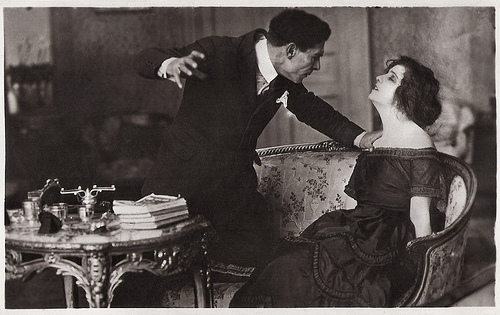
Italian postcard. Publicity still for La casa di vetro/The glass house (Gennaro Righelli, 1920), starring Maria Jacobini and Amleto Novelli .
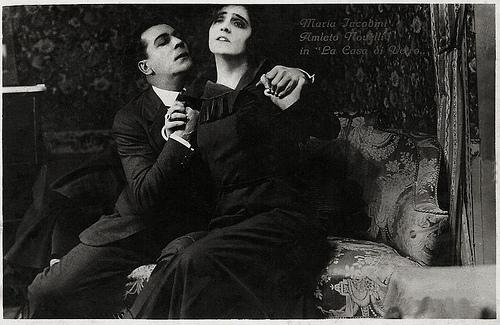
Italian postcard by G.B. Falci, Milano. Publicity still for La casa di vetro/The glass house (Gennaro Righelli, 1920), starring Maria Jacobini and Amleto Novelli .
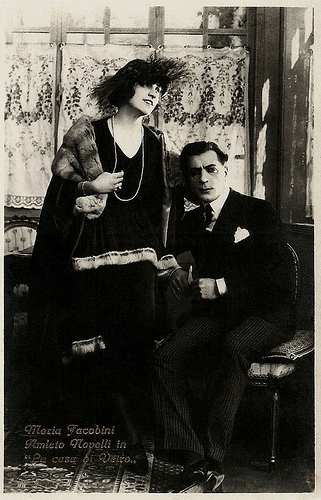
Italian postcard by G.B. Falci, Milano, no. 13. Publicity still for La casa di vetro/The glass house (Gennaro Righelli, 1920), starring Maria Jacobini and Amleto Novelli .
Source: Vittorio Martinelli and Aldo Bernardini (Il Cinema Muto Italiano, Vol. 1920 - Italian) and IMDb.

Italian postcard by G.B. Falci, Milano. Photo: publicity still for La casa di vetro/The glass house (Gennaro Righelli, 1920), starring Maria Jacobini and Amleto Novelli .

Italian postcard by G.B. Falci, Milano. Photo: publicity still for La casa di vetro/The glass house (Gennaro Righelli, 1920), with Maria Jacobini and Orietta Claudi.

Italian postcard. Caption on the back: 'Triste Natale' (Sad Christmas). Photo: Fert. Publicity still for La casa di vetro/The glass house (Gennaro Righelli, 1920), starring Maria Jacobini and Amleto Novelli .
Breaking glass
Italian diva Maria Jacobini plays in La casa di vetro/The glass house (Gennaro Righelli 1920) the mundane city girl Gaby Printemps. During a trip, and accompanied by her good fried Max (Oreste Bilancia), Gaby is struck by the quiet life in a mountain village, and decides to remain there.
She meets Roberto Landi ( Amleto Novelli ), a simple and honest young man, and the two fall in love, creating endless suffering for Roberto's fiancee Grazia (Orietta Claudi) and his parents. They move to the city, but their different life styles soon become evident.
Moreover, jealous Max tries to split them. Roberto's father (Alfonso Cassini) decides to find his son and confronts him with the words that Gaby belongs to the species which one loves but not marries. In the end, Roberto admits his failure.
At Christmas Eve he returns to the mountain village and reconciles with his old love Grazia and his parents. Gaby annihilates her memory by breaking a glass of champagne, as she says, "just like all glass houses do" (the title of the film).
In the Italian journal La vita cinematografica, Dioniso thought that 'the glass house' was a misleading title, pretending transparency while several secrets are going on at Gaby's. And in the end no home is destroyed as both lovers were not really planning to build one. The broken glass only refers to Gaby's broken heart. Instead, Dioniso praised the shots on location in the Italian countryside, at the foot of the Majella mountains.
Orietta Claudi had a relatively short career in Italian silent cinema of the early 1920s, mostly playing the young family girl opposite the mundane divas such as Pina Menichelli, Italia Almirante Manzini and Maria Jacobini .
Scripted by Luciano Doria and future film director Nunzio Malasomma, La casa di vetro was produced by the Fert company of Turin and distributed by Pittaluga. Cinematography was by Tullio Chiarini. La casa di vetro had its Roman premiere on 21 February 1921.

Italian postcard. Publicity still for La casa di vetro/The glass house (Gennaro Righelli, 1920), starring Maria Jacobini and Amleto Novelli .

Italian postcard by G.B. Falci, Milano. Publicity still for La casa di vetro/The glass house (Gennaro Righelli, 1920), starring Maria Jacobini and Amleto Novelli .

Italian postcard by G.B. Falci, Milano, no. 13. Publicity still for La casa di vetro/The glass house (Gennaro Righelli, 1920), starring Maria Jacobini and Amleto Novelli .
Source: Vittorio Martinelli and Aldo Bernardini (Il Cinema Muto Italiano, Vol. 1920 - Italian) and IMDb.
Published on April 03, 2018 22:00
April 2, 2018
Margarete Schlegel
Margarete Schlegel (1899–1987) was a German theatre and film actress and soprano operetta singer active in Germany between 1919-1933. Himmler proposed her to continue her film career under the Third Reich if she divorced her assimilated Jewish husband. She continued her career at the British radio till 1955.
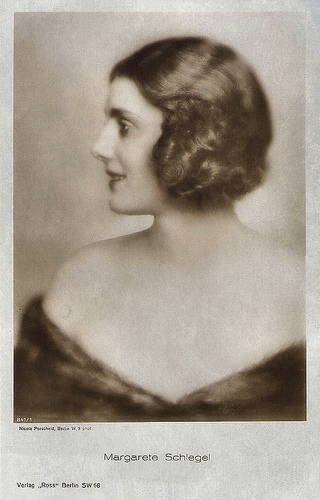
German postcard by Ross Verlag, no. 841/1, 1925-1926. Photo: Nicola Perscheid, Berlin
Naturally beautiful and talented
Margaret Schlegel was born 31 December 1899 in Bromberg, West Prussia, Germany, (now Bydgoszcz, Poland) to a German-speaking Prussian-Polish Catholic family. Her father was Augustin Heinrich Schlegel, who legally changed the family surname from Wisniewski to Schlegel upon relocating them to Berlin in 1904, while her mother was Anna Agatha Schlegel née Garski.
Naturally beautiful and talented (she could sing, dance and act very well from an early age), Margarete Schlegel sought a chorus role in theatre in 1917 as a way of earning extra money for her family while still a schoolgirl due to the hardship of the First World War.
This soon led to a starring role in the farce Charley’s Aunt at the Thalia Theatre and later both serious and comic roles at the Deutsches Theater in Berlin, where Margarete was trained and mentored by theatre director Max Reinhardt.
After the war, from 1919, she was frequently cast in the Weimar cinema, beginning with a small part in Paul Leni’s Prinz Kuckuck/Prince Cuckoo (1919), starring Conrad Veidt .
Already in her second film she had a female lead opposite Dutch actor Ern(e)st Winar in the Herman Bang adaptation Die Benefiz-Vorstellung der Vier Teufel/The Four Devils (A.W. Sandberg, 1920). Bang’s book already had been adapted for film by Alfred Lind in 1911 and would be used again by F.W. Murnau for his Four Devils (1928).
Next, she had the female lead in Der Januskopf/The Head of Janus (F.W. Murnau, 1920), a now lost Murnau film, starring Conrad Veidt and based on Robert Louis Stevenson’s The Strange Case of Dr. Jekyll and Mr. Hyde. She also had a major lead in his Sehnsucht/Desire (F.W. Murnau, 1920), another lost film, alas, about a Russian dancer (again Veidt), messed up in an intrigue between aristocracy and revolutionaries, which causes his beloved (Schlegel) to be sent to Siberia.
In 1921 followed films like Der ewige Fluch/The Eternal Curse (Fritz Wendhausen 1921), set in the Netherlands, Die Intriguen der Madame de la Pommeraye/Madame de La Pommeraye's Intrigues (Fritz Wendhausen, 1921), and Betrüger des Volkes/The Cheater of the People (Carl Heinz Boese, Reinhold Schünzel, 1921).
After various bit parts in the early 1920s, Schlegel had female leads again in the mountain film Die sterbende Stadt/The Dying City (Holger-Madsen 1921), produced by Arnold Fanck, and Liebe, Tor und Teufel/Love, Fool and Devil (Adolf Wenter, 1922) with Charles Willy Kayser – an actor with whom Schlegel often acted with.
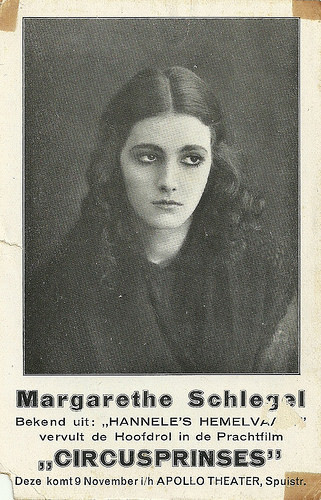
Dutch postcard. Publicity card for the showing of the film Die Magyarenfürstin (Werner Funck, 1923) at the The Hague Apollo Theater at Spuistraat. Schlegel is announced as the actress famous for Hannele's Himmelfahrt. The Dutch title for the film was The Circus Princess.
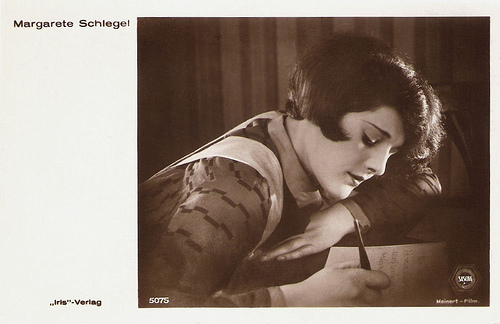
Austrian postcard by Iris Verlag, no. 5075. Photo: Sascha Film / Meinert-Film.
Mistreated and abused
After a supporting part in Sodoms Ende/Sodom's End (Felix Basch, 1922), Margarete Schlegel had one of her biggest roles in the religious film Hannele’s Himmelfahrt/Hannele's Ascension (Urban Gad, 1923), adapted from Gerhard Hauptmann’s book. Schlegel plays the title role as the stepchild of a rude man (Hermann Vallentin) who mistreats and abuses the girl, leading to her suicide after she has had a vision that heaven is better than life on earth.
The film altered some scenes in the beginning but kept the general plot and the mood from the second part of Hauptmann’s tale. The film had a grand premiere at the Berliner Staatsoper in 1922, and was well received. Walter Rilla as the angel of death had its debut in this film.
Schlegel played again with director A.W. Sandberg in his Danish Dickens adaptation David Copperfield (1922), acting as David's mother. She had another lead in Die Magyarenfürstin/The Magyar Princess (Werner Funck 1923), though it was not such a success as the previous film.
Again opposite Vallentin, Schlegel played the female lead in Das Geheimnis des Renngrafen/The Secret of the Rally Driver (A. Bergson, 1923), while she was Ernst Deutsch’s sweetheart in Das alte Gesetz/This Ancient Law (E.A. Dupont 1923), about a rabbi’s son (Deutsch), who becomes a stage actor and thanks to an Austrian archcountess ( Henny Porten ) is promoted to the highest ranks in the theatre world, but in the end reconciles with his father and returns to his village and his beloved. The film still exists.
After contributing to the educational film Wunder der Schöpfung/In the World of the Stars (1925) Schlegel acted opposite Charles Willy Kayser , Maria Minzenti, John Stuart and others in Die Frauen zweier Junggesellen (Franz Seitz sen., 1925), and opposite Ernst Reicher in his Stuart Webbs detective Der Schuss im Pavillion (Max Obal 1925).
After a few more films, Schlegel had again the lead in Zwei unterm Himmelszelt (Johannes Guter, 1927), adapted from a novel by Ludwig Wolff. She played a banker’s daughter opposite Ernst Deutsch as a taxi dancer, and Jean Angelo .
More films followed in the later 1920s, a.o. Die Zigeunerprimas/The Gypsy Chief (Carl Wilhelm 1929), an adaptation of the Emmerich Kálmán operetta, starring Paul Heidemann , and Der Sittenrichter/The Customs Judge (Carl Heinz Wolff, 1929), in which Schlegel had the lead.
During the 1920s, while working in the cinema, Margarete Schlegel continued to star in theatre roles and operettas, such as Franz Lehár's Merry Widow and Gypsy Love. Her soprano repertoire included arias and lieder by Jacques Offenbach, Giacomo Puccini, George Frideric Handel, Johannes Brahms, Richard Strauss and Johann Strauss, which she performed in recitals and radio broadcasts in addition to the musical numbers she sang in sound feature films.
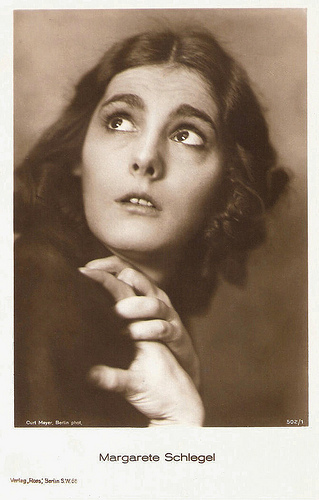
German postcard by Ross Verlag, no. 502/1, 1919-1924. Photo: Curt Mayer, Berlin.
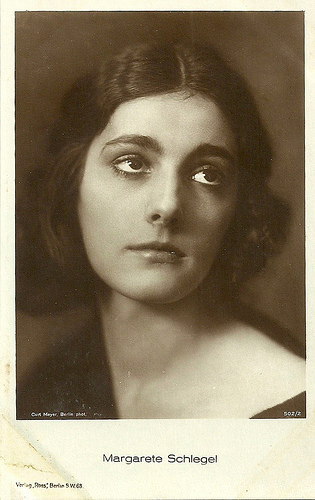
German postcard by Ross Verlag, no. 502/2, 1919-1924. Photo: Curt Mayer, Berlin.
Anti-Nazi German-language propaganda
In the early sound era of German cinema (1930-1932), Schlegel did few films anymore, but some very interesting ones.
Billy Wilder wrote the screenplay of her last German film, a romantic operetta comedy called Das Blaue vom Himmel/The Blue from the Sky (Viktor Janson, 1932), starring Márta Eggerth and Hermann Thimig . The film was released in December 1932 just prior to Hitler's ascent to power and therefore not subject to Nazi dictates.
Her best known and penultimate film was Phil Jutzi’s morality play Berlin-Alexanderplatz: Die geschichte Franz Biberkopfs (1931), adapted from Alfred Döblin’s novel (later adapted by R.W. Fassbinder as well).
Here Schlegel played Sonja, later called Mieze, Franz' new girl who is eventually killed by the evil criminal Reinhold (Bernhard Minetti). The film focuses on Heinrich George as the ex-convict Franz Biberkopf who is drawn into the Berlin underworld.
In all, Schlegel appeared in 35 silent films and three sound films of differing styles during the Weimar era. In 1924 Margarete Schlegel had married the assimilated Jewish-Prussian political economist, Prof Hermann Joachim Levy. In 1926 they had a son, Hermann Martin Heinrich Levy, who was baptised Catholic.
When in May 1933 her husband was dismissed from university by the Nazis, and his academic books and novels were burned, he travelled to Britain as visiting professor in Cambridge. Margarete Schlegel declined offers from friends in Hollywood.
In 1935 she was offered the chance by Heinrich Himmler to continue her film career under the Third Reich on the condition that as an Aryan she divorced her assimilated Jewish husband, but instead she fled with her son to join her husband in Britain. By consequence, in 1938 the Nazis officially proscribed her films, her husband was added to Hitler's death list of opponents, and their home was seized by the Nazis.
After arriving in England, Schlegel became a featured soprano on BBC Radio in operas and operettas in the late 1930s. During WW II she broadcast anti-Nazi German-language propaganda radio programs for BBC Europe which were heard across the continent.
After her husband died in 1949 from a heart attack, she remarried and moved to Saltdean on the Sussex coast in England. In the 1950s she continued broadcasting for BBC Radio, singing in operettas. She also sang and spoke in German language educational radio programs for the BBC from 1938 onwards.
Margarete Schlegel died in 1987.
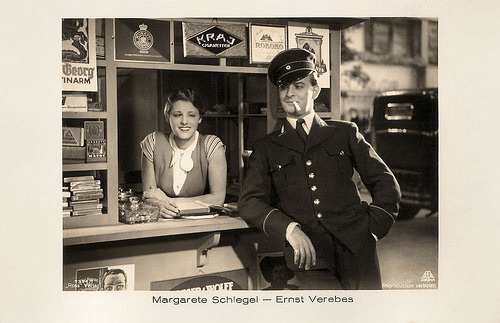
German postcard by Ross Verlag, no. 7394/1, 1932-1933. Photo: Aafa Film. Publicity still for Das blaue vom Himmel/The Blue from the Sky (Victor Janson, 1932) with Ernst Verebes.
Sources: Filmportal.de, Wikipedia (German and English), and .

German postcard by Ross Verlag, no. 841/1, 1925-1926. Photo: Nicola Perscheid, Berlin
Naturally beautiful and talented
Margaret Schlegel was born 31 December 1899 in Bromberg, West Prussia, Germany, (now Bydgoszcz, Poland) to a German-speaking Prussian-Polish Catholic family. Her father was Augustin Heinrich Schlegel, who legally changed the family surname from Wisniewski to Schlegel upon relocating them to Berlin in 1904, while her mother was Anna Agatha Schlegel née Garski.
Naturally beautiful and talented (she could sing, dance and act very well from an early age), Margarete Schlegel sought a chorus role in theatre in 1917 as a way of earning extra money for her family while still a schoolgirl due to the hardship of the First World War.
This soon led to a starring role in the farce Charley’s Aunt at the Thalia Theatre and later both serious and comic roles at the Deutsches Theater in Berlin, where Margarete was trained and mentored by theatre director Max Reinhardt.
After the war, from 1919, she was frequently cast in the Weimar cinema, beginning with a small part in Paul Leni’s Prinz Kuckuck/Prince Cuckoo (1919), starring Conrad Veidt .
Already in her second film she had a female lead opposite Dutch actor Ern(e)st Winar in the Herman Bang adaptation Die Benefiz-Vorstellung der Vier Teufel/The Four Devils (A.W. Sandberg, 1920). Bang’s book already had been adapted for film by Alfred Lind in 1911 and would be used again by F.W. Murnau for his Four Devils (1928).
Next, she had the female lead in Der Januskopf/The Head of Janus (F.W. Murnau, 1920), a now lost Murnau film, starring Conrad Veidt and based on Robert Louis Stevenson’s The Strange Case of Dr. Jekyll and Mr. Hyde. She also had a major lead in his Sehnsucht/Desire (F.W. Murnau, 1920), another lost film, alas, about a Russian dancer (again Veidt), messed up in an intrigue between aristocracy and revolutionaries, which causes his beloved (Schlegel) to be sent to Siberia.
In 1921 followed films like Der ewige Fluch/The Eternal Curse (Fritz Wendhausen 1921), set in the Netherlands, Die Intriguen der Madame de la Pommeraye/Madame de La Pommeraye's Intrigues (Fritz Wendhausen, 1921), and Betrüger des Volkes/The Cheater of the People (Carl Heinz Boese, Reinhold Schünzel, 1921).
After various bit parts in the early 1920s, Schlegel had female leads again in the mountain film Die sterbende Stadt/The Dying City (Holger-Madsen 1921), produced by Arnold Fanck, and Liebe, Tor und Teufel/Love, Fool and Devil (Adolf Wenter, 1922) with Charles Willy Kayser – an actor with whom Schlegel often acted with.

Dutch postcard. Publicity card for the showing of the film Die Magyarenfürstin (Werner Funck, 1923) at the The Hague Apollo Theater at Spuistraat. Schlegel is announced as the actress famous for Hannele's Himmelfahrt. The Dutch title for the film was The Circus Princess.

Austrian postcard by Iris Verlag, no. 5075. Photo: Sascha Film / Meinert-Film.
Mistreated and abused
After a supporting part in Sodoms Ende/Sodom's End (Felix Basch, 1922), Margarete Schlegel had one of her biggest roles in the religious film Hannele’s Himmelfahrt/Hannele's Ascension (Urban Gad, 1923), adapted from Gerhard Hauptmann’s book. Schlegel plays the title role as the stepchild of a rude man (Hermann Vallentin) who mistreats and abuses the girl, leading to her suicide after she has had a vision that heaven is better than life on earth.
The film altered some scenes in the beginning but kept the general plot and the mood from the second part of Hauptmann’s tale. The film had a grand premiere at the Berliner Staatsoper in 1922, and was well received. Walter Rilla as the angel of death had its debut in this film.
Schlegel played again with director A.W. Sandberg in his Danish Dickens adaptation David Copperfield (1922), acting as David's mother. She had another lead in Die Magyarenfürstin/The Magyar Princess (Werner Funck 1923), though it was not such a success as the previous film.
Again opposite Vallentin, Schlegel played the female lead in Das Geheimnis des Renngrafen/The Secret of the Rally Driver (A. Bergson, 1923), while she was Ernst Deutsch’s sweetheart in Das alte Gesetz/This Ancient Law (E.A. Dupont 1923), about a rabbi’s son (Deutsch), who becomes a stage actor and thanks to an Austrian archcountess ( Henny Porten ) is promoted to the highest ranks in the theatre world, but in the end reconciles with his father and returns to his village and his beloved. The film still exists.
After contributing to the educational film Wunder der Schöpfung/In the World of the Stars (1925) Schlegel acted opposite Charles Willy Kayser , Maria Minzenti, John Stuart and others in Die Frauen zweier Junggesellen (Franz Seitz sen., 1925), and opposite Ernst Reicher in his Stuart Webbs detective Der Schuss im Pavillion (Max Obal 1925).
After a few more films, Schlegel had again the lead in Zwei unterm Himmelszelt (Johannes Guter, 1927), adapted from a novel by Ludwig Wolff. She played a banker’s daughter opposite Ernst Deutsch as a taxi dancer, and Jean Angelo .
More films followed in the later 1920s, a.o. Die Zigeunerprimas/The Gypsy Chief (Carl Wilhelm 1929), an adaptation of the Emmerich Kálmán operetta, starring Paul Heidemann , and Der Sittenrichter/The Customs Judge (Carl Heinz Wolff, 1929), in which Schlegel had the lead.
During the 1920s, while working in the cinema, Margarete Schlegel continued to star in theatre roles and operettas, such as Franz Lehár's Merry Widow and Gypsy Love. Her soprano repertoire included arias and lieder by Jacques Offenbach, Giacomo Puccini, George Frideric Handel, Johannes Brahms, Richard Strauss and Johann Strauss, which she performed in recitals and radio broadcasts in addition to the musical numbers she sang in sound feature films.

German postcard by Ross Verlag, no. 502/1, 1919-1924. Photo: Curt Mayer, Berlin.

German postcard by Ross Verlag, no. 502/2, 1919-1924. Photo: Curt Mayer, Berlin.
Anti-Nazi German-language propaganda
In the early sound era of German cinema (1930-1932), Schlegel did few films anymore, but some very interesting ones.
Billy Wilder wrote the screenplay of her last German film, a romantic operetta comedy called Das Blaue vom Himmel/The Blue from the Sky (Viktor Janson, 1932), starring Márta Eggerth and Hermann Thimig . The film was released in December 1932 just prior to Hitler's ascent to power and therefore not subject to Nazi dictates.
Her best known and penultimate film was Phil Jutzi’s morality play Berlin-Alexanderplatz: Die geschichte Franz Biberkopfs (1931), adapted from Alfred Döblin’s novel (later adapted by R.W. Fassbinder as well).
Here Schlegel played Sonja, later called Mieze, Franz' new girl who is eventually killed by the evil criminal Reinhold (Bernhard Minetti). The film focuses on Heinrich George as the ex-convict Franz Biberkopf who is drawn into the Berlin underworld.
In all, Schlegel appeared in 35 silent films and three sound films of differing styles during the Weimar era. In 1924 Margarete Schlegel had married the assimilated Jewish-Prussian political economist, Prof Hermann Joachim Levy. In 1926 they had a son, Hermann Martin Heinrich Levy, who was baptised Catholic.
When in May 1933 her husband was dismissed from university by the Nazis, and his academic books and novels were burned, he travelled to Britain as visiting professor in Cambridge. Margarete Schlegel declined offers from friends in Hollywood.
In 1935 she was offered the chance by Heinrich Himmler to continue her film career under the Third Reich on the condition that as an Aryan she divorced her assimilated Jewish husband, but instead she fled with her son to join her husband in Britain. By consequence, in 1938 the Nazis officially proscribed her films, her husband was added to Hitler's death list of opponents, and their home was seized by the Nazis.
After arriving in England, Schlegel became a featured soprano on BBC Radio in operas and operettas in the late 1930s. During WW II she broadcast anti-Nazi German-language propaganda radio programs for BBC Europe which were heard across the continent.
After her husband died in 1949 from a heart attack, she remarried and moved to Saltdean on the Sussex coast in England. In the 1950s she continued broadcasting for BBC Radio, singing in operettas. She also sang and spoke in German language educational radio programs for the BBC from 1938 onwards.
Margarete Schlegel died in 1987.

German postcard by Ross Verlag, no. 7394/1, 1932-1933. Photo: Aafa Film. Publicity still for Das blaue vom Himmel/The Blue from the Sky (Victor Janson, 1932) with Ernst Verebes.
Sources: Filmportal.de, Wikipedia (German and English), and .
Published on April 02, 2018 22:00
Paul van Yperen's Blog
- Paul van Yperen's profile
- 13 followers
Paul van Yperen isn't a Goodreads Author
(yet),
but they
do have a blog,
so here are some recent posts imported from
their feed.



